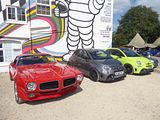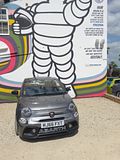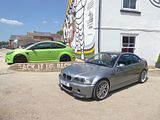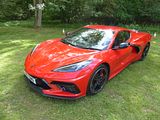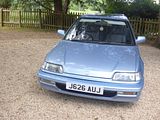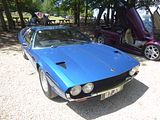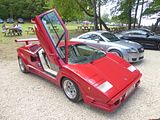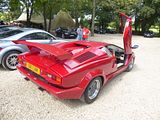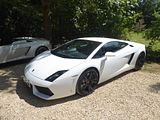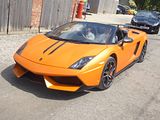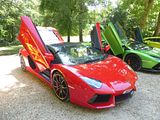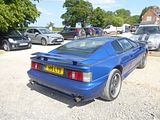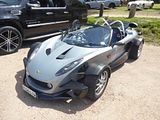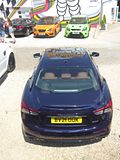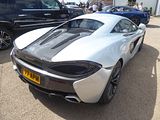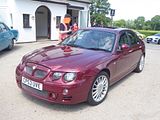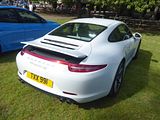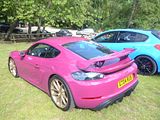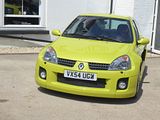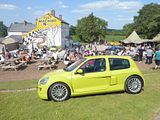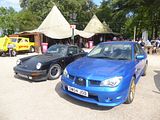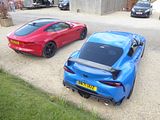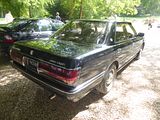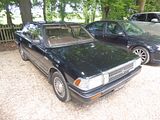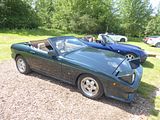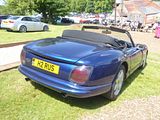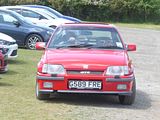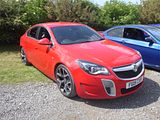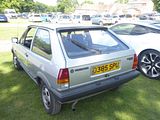Just a week or so after visiting Caffeine & Machine, here I am again. And why not? In the less than five years since the location opened, it has become a sort of automotive mecca, attracting all manner of enthusiasts from far and wide who come here to show off their car, look at the cars and bikes that others have brought, take advantage of good quality and reasonably priced food and drinks and to talk with friends. Many Car Clubs use this venue as a meeting point, some more formally than others, so no-one including the location’s own staff, really knows quite who or what will turn up. Sometimes, though, publicity on-line is such that there are some strong clues and this was one of those occasions, as it was declared in various places that there would be a significant supercar presence over the weekend with a strong showing of Lamborghini models, in some cases as the cars were en route to an event at Sywell the following day, which indeed was also my plan. That was all the incentive I needed, especially as this location, just outside Stratford on Avon was between home and where I was headed for the Sunday. I duly secured a ticket, which gave me a three hour window to be on site, and charged the camera batteries in readiness. Here is what I saw:
ABARTH
There are usually a few Abarths here even when no official meet has been organised and that was the case this time. A couple of them were from the now long-lived 500-based family. The Series 4 version reached the markets in the middle of 2016. After rumours had circulated all winter following the launch of the facelifted Fiat 500 in 2015, Abarth finally unveiled the Series 4 at the end of May 2016. Initially, we were told that the cars would not be available in the UK until September, but that came forward somewhat, with dealers all receiving demo cars in June, and the first customers taking delivery in July. Three regular production versions of both the closed car and the open-topped C were initially available, all badged 595, and called Custom, Turismo and Competizione, as before, though numerous limited edition models have since appeared and in most case disappeared. The most significant changes with the Series 4 are visual, with a couple of new colours, including the much asked for Modena Yellow and a different red, called Abarth Red, which replaces both the non-metallic Officina and – slightly surprisingly – the tri-coat pearlescent Cordolo Red. as well as styling changes front and rear. The jury is still out on these, with many, me included, remaining to be convinced. At the front, the new air intake does apparently allow around 15 – 20 % more air in and out, which will be welcome, as these cars do generate quite a lot of heat under the bonnet. Competizione models for the UK retain the old style headlights, as they have Xenon lights as standard, whereas the Custom and Turismo cars have reshaped units. At the back, there are new light clusters and a new rear bumper and diffuser. Inside, the most notable change is the replacement of the Blue & Me system with a more modern uConnect Audio set up, which brings a new colour screen to the dash. Mechanically, there is an additional 5 bhp on the Custom (now 145) and Turismo (now 165 bhp) and the option of a Limited Slip Diff for the Competizione, which is likely to prove a popular option. Details of the interior trim have changed, with a filled-in glovebox like the US market cars have always had, and electric windows switches that are like the US ones, as well as a part Alcantara trim to the steering wheel in Competizione cars.
The Abarth Grande Punto debuted at the 2007 Frankfurt IAA Show, going on sale in the UK in late summer of 2008. Offering 155 bhp from its 1.4 litre T-Jet engine, coupled to a six speed gearbox, and riding on 45 profile 17″ alloys, the standard car got rave reviews from the journalists when they first tried it, and they were even more impressed by the changes wrought by the optional Esseesse kit. This increased power to 177 bhp, brought 18″ OZ lower profile wheels, whilst new springs lowered the ride height by 15-20mm, and high-performance front brake pads and cross-drilled front disc brakes helped the car to stop more quickly. The most distinctive feature of the car were the white alloy wheels, though, as owners found, keeping these clean is not a job for the uncommitted, and many have a second set of wheels that they use for grubbier conditions. Despite the positive press at launch, the car entered a very competitive sector of the market, and the combination of being relatively unknown, a limited number of dealers and the existence of established rivals from Renault and others meant that this always remained a left-field choice. The owners loved them, though, and they still do. The oldest cars have now had their 14th birthdays, and some have amassed relatively big mileages, but they are still a car for the cognoscenti.
ALFA ROMEO
Replacement for the much loved 156 was the 159. The Alfa Romeo 159 had a troubled development, being designed in the midst of the Fiat-General Motors joint venture which was terminated in 2005. Originally, the 159 was intended to use GM’s Epsilon platform; however, late during its development it was changed to the GM/Fiat Premium platform. The Premium platform was more refined and expensive, being intended for E-segment executive cars such as an Alfa Romeo 166 successor but that never materialised, so Alfa Romeo attempted to recoup some of the platform development costs with the 159. General Motors originally planned Cadillac, Buick and Saab models for this platform but ending up discarded them over cost concerns. Unfortunately, the 159’s late transition to what was fundamentally made as an E-segment platform resulted in the 159 having excessive weight, a problem shared by its sisters, the Alfa Romeo Brera coupe and Spider convertible. The 159 was designed by Giorgetto Giugiaro in collaboration with the Centro Stile Alfa Romeo. The nose featured a traditional Alfa Romeo V-shaped grille and bonnet, and cylindrical head light clusters. Similar to its coupé counterpart, front of the car was influenced by the Giugiaro designed 2002 Brera Concept. Several exterior design cues were intended to make the car appear larger, supposedly to appeal to potential buyers in the United States; however, the 159 was never exported to that region. The interior featured styling treatments familiar from earlier cars, including the 156, such as deeply recessed instruments which are angled towards the driver. Alfa Romeo intended for the 159 to compete more directly with BMW, Mercedes-Benz and Audi by using higher quality interior materials; however, it has been said that Alfa Romeo misjudged their brand’s positioning relative to the more well-known German luxury automakers. Several levels of trim were available, depending on market. Four trim levels: Progression, Distinctive, Exclusive and Turismo Internazionale (TI) featured across Europe. In the UK there were three levels of trim: Turismo, Lusso and Turismo Internazionale (TI). A Sportwagon variant was introduced at the Geneva Motor Show in 2006. The 159’s size made it considerably more comfortable than the 156 due to its larger, roomy interior. However, the considerable growth in dimensions deterred many 156 owners from considering the 159 as a direct replacement model, and something seemed to be lost in the character of the new car. Initially offered with a choice of 1.9 and 2,2 litre 4 cylinder and 3.2 litre V6 petrol engines and 1.9 and 2.4 litre diesel units, and an optional four wheel drive system. An automatic gearbox option for the 2.4 JTDM diesel model was also launched in late 2006, and later extended to other versions. In 2007 a four-wheel drive diesel model was released and the 2.4-litre diesel engines’ power output increased to 210 hp, with a newly reintroduced TI trim level also available as an option. For model year 2008 the mechanics and interiors of the 159 were further developed. The 3.2 litre V6 model was offered in front wheel drive configuration, achieving a top speed of 160 mph. All model variants came with Alfa’s electronic “Q2” limited slip differential. As a result of newly introduced aluminium components, a 45 kilograms (99 lb) weight reduction was achieved. For 2009, Alfa introduced a new turbocharged petrol engine badged as “TBi”. This 1742 cc unit had direct injection and variable valve timing in both inlet and exhaust cams. This new engine had 200 PS (197 hp) and would eventually replace the GM-derived 2.2 and 1.9 JTS units.In 2010, all petrol engines except for the 1750 TBi were retired, ending the use of General Motors-based engines in the 159. The only remaining diesel engines were the 136 PS and 170 PS 2.0 JTDm engines. In 2011, the 159 was powered only by diesel engines. In the UK, Alfa Romeo stopped taking orders for the 159 on 8 July 2011. Production for all markets ceased at the end of 2011, after 240,000 had been built.
ARMSTRONG SIDDELEY
This unrestored car is a Lancaster, which was produced from 1945 until 1952. It was the first post-war sports saloon to be made by the company, replacing the pre-war 16HP model. The chassis of the Lancaster was all new and featured independent front suspension using torsion bars and a live rear axle with leaf springs. A Girling hydro-mechanical braking system was fitted, with the front drums hydraulically operated while those at the rear used rod and cable. Wire wheels were an option but rarely fitted. At first, the Lancaster was fitted with a 70 bhp 1991 cc six cylinder engine, carried over from the pre-war 16 hp model but from 1949 this grew to 2309 cc by increasing the cylinder bore from 65 to 70 mm. There was a choice of 4-speed synchromesh or pre-selector gearbox. The four-door, six light body was made of steel and aluminum panel fitted over a wooden frame and was bought in from Mulliners of Birmingham. An opening sunshine roof was standard. 3597 were made before the car was replaced by the Whitley.
ASTON MARTIN
The latest and still current Aston Martin Vantage was unveiled on 21 November 2017 with production starting in June 2018, replacing the previous model which had been in production for 12 years. It introduced a new styling direction but this was not universally well received and the car had a hefty price increase over its predecessor. Muted press enthusiasm did not help and sales have been disappointing. Aston Martin have continued to develop the model with a number of new versions introduced, to try to improve demand. The Vantage AMR is a track-focused variant of the Vantage. The main highlight of the model is the replacement of the ZF 8-speed automatic transmission with a dog-leg Graziano Trasmissioni 7-speed manual transmission previously used on the V12 Vantage S. The AMR also comes with a driver-selectable AMSHIFT system which controls the throttle during gear shifting. A new limited-slip differential ensures linear delivery of power. The power-band of the engine is wider and the unit is designed to deliver 625 N⋅m (461 lb⋅ft) of torque from 2,000 rpm to 5,000 rpm. The use of a manual transmission and carbon-ceramic brakes reduce the weight by 95 kg (209 lb). New adaptive dampers with the section of Sport, Sport + and Track modes improve handling. Performance figures include a 0–97 km/h (60 mph) acceleration time of 3.9 seconds, half a second more than the standard Vantage while the top speed remains the same as the standard model. Visual changes include 20-inch forged wheels as available on the Rapide AMR, new carbon fibre side vents and cooling vents present on the hood a sports exhaust system with quad tailpipes and racing bucket seats. Production of the AMR will be limited to 200 units worldwide. Available exterior colours for the AMR include Sabiro Blue, Pnyx Black, China Grey and White Stone. The final 59 cars will be finished in a Sterling Green exterior colour with Lime accents and will pay homage to the 1959 24 Hours of LeMans victory of Aston Martin. Once the production of the AMR ceases, the 7-speed manual transmission will become available on the standard Vantage. The vehicle went on sale in May 2019, with delivery set to begin in Q4 2019. Revealed in February 2020, the Vantage Roadster is a convertible version of the V8 Coupe with a fabric roof. The roof claimed to be the fastest of any automotive automatic convertible system, takes 6.7 seconds to lower and 6.8 seconds to raise and can be operated at speeds of up to 50 km/h (31 mph). The Vantage Roadster has a dry weight of 1,628 kg (3,589 lb). The F1 Edition is a version of the V8 Coupe and V8 Roadster commemorating Aston Martin’s return to Formula One after 61 years. The car features a fixed rear wing at the back, increased engine power to 535 PS (528 bhp), a top speed of 314 km/h (195 mph), new 21-inch wheel rims, and a 0–100 km/h (0–62 mph) acceleration time of 3.5 seconds. The car is available in three colours: Aston Martin Racing Green, Jet Black, and Lunar White. A convertible version called the Roadster is also available. Delivery began in May 2021.
AUDI
Still highly rated more than a decade after production ceased is the B7 generation RS4, seen here in regular Saloon guise. There was no RS4 built on the Audi “B6” platform that served as the basis for the Audi A4 between 2001 and 2005. However, after a long hiatus, the second Audi RS4 quattro (Typ 8E), was built on Audi’s “B7” A4 platform. It was unveiled in February 2005. The RS4 became available to European customers in mid-2006. It was introduced at the 2006 North American International Auto Show in January, and arrived in June 2006 in North America. The B7 RS4 was an almost complete departure from previous Audi “RS” cars, as it was initially available as a four-door five-seat saloon with a five-door five-seat Avant and two-door four-seat Cabriolet versions arriving later. Only the Audi RS6 had taken this similar route (saloon and Avant) before; the previous RS4 and RS2 were available exclusively as Avants. Constructed from fully galvanised steel, the B7 RS4 uses lightweight aluminium for its front wings and bonnet. The saloon version features a drag coefficient (Cd) of 0.31, from a frontal area of 2.17 m2. Like its B5 predecessor, visually, the B7 RS4 differs from its related B7 S4, by having even wider flared front and rear wheel arches, to allow for a wider axle track. Over the B7 A4, it also includes two larger frontal side air intakes (for the two additional side-mounted coolant radiators). The trim on the saloon and roof rails on the estate are chrome as standard but can also be found in black with the addition of the Optic Pack which includes a black front grill, all exterior trim and black roof rails on the estate version. The B7 RS4 also includes an optional adaptive headlights to complement the standard “Xenon Plus” (Bi-Xenon) High Intensity Discharge (HID) headlamps, which swivel around corners in conjunction with steering wheel movements. Also standard are daytime running lights (DRLs), found within the main headlamp housings, identical to its related B7 A4 and S4, and use a conventional tungsten filament bulb. An acoustic parking system with front and rear sensors is also a standard fitment. Unique carbon fibre interior trims, along with a lap timer within the central Driver Information System (DIS), aluminium pedal caps and footrest, and RS 4 logos complete the look. Kerb weight of the saloon variant starts at 1,650 kg (3,638 lb). The engine of the B7 RS4 is based on the existing all-alloy 4,163 cc V8 from the B6 S4, and shares many parts, and Fuel Stratified Injection, with the 4.2 FSI V8 engine in the Q7. The engine includes new cylinder block construction, and is a highly reworked, high-revving variant (redline at 8,000 rpm; rev limit of 8,250 rpm). The same engine base was used for the Audi R8 when Audi wanted to build their first supercar. However, the camshaft drive system was moved to the front of the block for the mid-engine R8. Audi factory numbers indicate that the B7 RS4 saloon can accelerate from 0 to 100 km/h (0 to 62 mph) in 4.8 seconds, and arrive at 0 to 200 km/h (0 to 124 mph) in 16.6 seconds. Top speed for all variants is “officially” electronically limited to 250 km/h (155.3 mph), though some owners reported that the speed limiter is rather “liberal”, conforming to the pattern of previous Audi “RS” cars, with genuine top speeds of 270 km/h (168 mph) being recorded. The production run of the B7 RS 4 was 2006 to 2008 inclusive. Approximately 10,000 B7 RS4s were built, of which around 2,000 went to the USA.
AUSTIN HEALEY
Donald Healey had been producing a range of expensive sports cars from the 1940s, cars such as the Silverstone, the Abbott and the Farnham. For the 1952 London Motor Show, he produced a new design, which was called the Healey Hundred, based on Austin A90 mechanicals, which he intended to produce in-house at his small car company in Warwick. It was one of the stars of the 1952 Show, and it so impressed Leonard Lord, the Managing Director of Austin, who was looking for a replacement to the unsuccessful A90. that Lord struck a deal with Healey on the spot, to build it in quantity. Bodies made by Jensen Motors would be given Austin mechanical components at Austin’s Longbridge factory. The car was renamed the Austin-Healey 100, in reference to the fact that the car had a top speed of 100 mph. Production got under way in 1953, with Austin-Healey 100s being finished at Austin’s Longbridge plant alongside the A90 and based on fully trimmed and painted body/chassis units produced by Jensen in West Bromwich—in an arrangement the two companies previously had explored with the Austin A40 Sports. By early 1956, production was running at 200 cars a month, 150 of which were being sold in California. Between 1953 and 1956, 14,634 Austin-Healey 100s were produced, the vast majority of them, as was the case for most cars in this post war era, going for export. The car was replaced by an updated model in 1956, called the 100-6. It had a longer wheelbase, redesigned bodywork with an oval shaped grille, a fixed windscreen and two occasional seats added (which in 1958 became an option with the introduction of the two-seat BN6 produced in parallel with the 2+2 BN4), and the engine was replaced by one based on the six-cylinder BMC C-Series engine. In 1959, the engine capacity was increased from 2.6 to 2.9 litres and the car renamed the Austin-Healey 3000. Both 2-seat and 2+2 variants were offered. It continued in this form until production ceased in late 1967. The Big Healey, as the car became known after the 1958 launch of the much smaller Austin-Healey Sprite, is a popular classic now. You come across the 3000 models more frequently than the 100s, as they accounted for more than 60% of all Big Healey production.
BMW
The first car to bear the 6 Series nomenclature was the E24, which was launched in 1976, as a replacement for the E9 model 3.0 CS and CSL coupés first produced in 1965. The 3.0 CS was almost changed by adding a few centimeters in height to make it easier for customers to get into the car. However, Bob Lutz rebelled against the decision and rough drafted an alternative version that soon became the 6 series. Production started in March 1976 with two models: the 630 CS and 633 CSi. Originally the bodies were manufactured by Karmann, but production was later taken in-house to BMW. In July 1978 a more powerful variant, the 635 CSi, was introduced that featured as standard a special close-ratio 5-speed gearbox and a single piece black rear spoiler. The bigger bore and shorter stroke facilitated max 218 hp at 5200rpm and a better torque curve. For the first year, the 635 CSi was offered in three colours (Polaris, Henna Red, Graphite), and could also be spotted by the front air dam that did not have attached fog lights. These simple cosmetic changes reportedly worked to reduce uplift on the car at high speeds by almost 15% over the non-spoiler body shape. This early model shared suspension components with the inaugural BMW 5-series, the E12. In 1979 the carburettor 630 CS was replaced with the 628 CSi with its fuel injected 2.8 litre engine taken from the BMW 528i. In 1980 the 635 CSi gained the central locking system that is also controlled from the boot. Also, the E24 body style converted from L-jetronic injection to a Bosch Motronic DME. In 1982 (Europe) and 1983 (US), the E24 changed slightly in appearance, with an improved interior and slightly modified exterior. At the same time, the 635 CSi received a new engine, a slightly smaller-bored and longer-stroked 3430 cc six to replace the former 3453 cc engine and became available with a wide-ratio 5-speed manual or an automatic. This slight change was in fact a major change as pre-1982 cars were based on the E12 5-series chassis; after mid-1982, E24s shared the improved E28 5-series chassis. The only parts that remained the same were some of the exterior body panels. E24s produced after June 1987 came with new, ellipsoid headlamps which projects beam more directly onto road surface (newly introduced E32 7-series also sporting them). The sleeker European bumpers were also discontinued. Previous cars had either a European-standard bumper or a larger, reinforced bumper to meet the US standard requiring bumpers to withstand impact at 5 mph without damage to safety-related components. 1989 was the last year for the E24 with production stopping in April. The E24 was supplanted by the considerably heavier, more complex, and more exclusive 8 Series. BMW Motorsport introduced the M 635 CSi in Europe at the Frankfurt Motor Show in 1983. It is essentially an E24 powered by the powerplant of the BMW M1 – the M88 with 286 PS). Most of the cars were equipped with special metric 415 mm diameter wheels requiring Michelin TRX tyres. A catalysed, lower compression ratio version of the car with the S38 engine (260 PS ) was introduced in the U.S. in 1987. All M6 cars came standard with a 25% rear limited slip differential. U.S. models included additional comforts that were usually optional on models sold in Europe such as Nappa leather power seats and a dedicated rear A/C unit with a centre beverage chiller. 4,088 M635CSi cars were built between 1983 and 1988 with 1,767 U.S. M6 built.
The M3 model of the E36 3 Series was released in November 1992 and was initially available as a coupé only, with a convertible version added in 1994. A sedan version was also added in December 1994, to fill in the gap caused by the lack of the M5 sedan model between the end of E34 M5 production in 1995 and the launch of the E39 M5 in 1998. In September 1995, a facelift version of the coupé was introduced. Changes included the engine displacement increasing to 3.2 L, the manual transmission upgrading from a 5-speed to a 6-speed, different wheels and clear indicator lenses. The facelift changes were applied to the sedan model in November 1995 and the convertible model in February 1996. The kerb weight of the 1996 M3 coupe in European specification is 1,515 kg (3,340 lb). The facelift also saw the introduction of a 6-speed “SMG” automated manual transmission, the first time an automated transmission was available on an M3 outside the United States. The SMG transmission was praised for its fast shift times and operation in performance situations, but criticized for behaviour in everyday driving situations. The M3 Evolution Imola Individual is a limited-edition variant of the M3 (50 for the United Kingdom). The engine and performance characteristics of the car were unchanged from the 1996 European M3, and a special exterior and interior colour combination was chosen by BMW UK: “Imola Red” (405) paint with Nappa leather seats in Imola Red and Amaretta suede bolsters in anthracite. It also included side airbags, the M3 GT Class II rear spoiler, front class II corner splitter extensions, electric seats, and double-spoke polished alloy wheels.
The M3 version of the E46 3 Series was produced in coupé and convertible body styles. The E46 M3 is powered by the S54 straight-six engine and has a 0-100 km/h (62 mph) acceleration time of 5.1 seconds for the coupe, with either the manual or SMG-II transmission. The skid pad cornering results are 0.89 g for the coupe and 0.81 g for the convertible. The top speed is electronically limited to 250 km/h (155 mph). The available transmissions were a Getrag 420G 6-speed manual transmission or a SMG-II 6-speed automated manual transmission, which was based on the Getrag 420G. The SMG-II used an electrohydraulically actuated clutch and gearshifts could be selected via the gear knob or paddles mounted on the steering wheel. The SMG-II was praised for its fast shift times and racetrack performance, but some people found its shifts to be delayed and lurching in stop-start traffic. In 2005, a special edition was introduced which used several parts from the CSL. This model was called the M3 Competition Package (ZCP) in the United States and mainland Europe, and the M3 CS in the United Kingdom. Compared to the regular M3, the Competition Package includes: 19-inch BBS alloy wheels- 19″x 8″ at the front and 19″x 9.5″ at the rear; Stiffer springs (which were carried over to the regular M3 from 12/04); Faster ratio steering rack of 14.5:1 (compared with the regular M3’s ratio of 15.4:1) as per the CSL; Steering wheel from the CSL; M-track mode for the electronic stability control, as per the CSL; The CSL’s larger front brake discs (but with the regular M3 front calipers) and rear brake calipers with larger pistons; Alcantara steering wheel and handbrake covers; The engine, gearbox and other drivetrain components are the same as the standard M3. Total production of the E46 M3 was 56,133 coupes and 29,633 convertibles. The cars were assembled at the BMW Regensburg factory in Germany and production was from September 2000 until August 2006, production totalled 85,766.
CHEVROLET
The next-generation (C7) Corvette had been in development since 2007. Originally set to be introduced for the 2011 model year, its introduction was delayed for 3 years. It was finally released for the 2014 model year. Mid-engine and rear-engine layouts had been considered, but the front-engine, rear-wheel drive platform was chosen to keep production costs lower. To GM’s product planners and marketers, the fact that the Corvette had become known as an “old man’s toy” became a prime factor in developing the next generation. Studies showed that about 46 percent of Corvette buyers in 2012, through October, were 55 or older, compared with 22 percent of Audi R8 and 30 percent of Porsche 911 customers. The head of Chevy marketing, Chris Perry, acknowledges that too many people saw it as the car of “the successful plumber.” John Fitzpatrick, Corvette’s marketing manager said “It’s the old saying, ‘Nobody wants to be seen driving an old man’s car, but everybody wants to be seen driving a young man’s car. ” To counter that perception GM planned to make the new generation C7 more aspirational to younger people. Towards that end, a camouflaged version of the car was made available in the popular video game Gran Turismo 5 in November 2012. As part of the marketing effort associated with the introduction of the new generation, the 2013 Indianapolis 500 utilised a Corvette for the 12th time as its pace car. Pace car editions are planned. Sales success of the new Corvette is important to GM. The Motley Fool reports that the Corvette could be earning GM $10,000 or more in gross profit for every Corvette it sells. The 2014 Chevrolet Corvette uses an LT1 6.2 litre V8 making 455 bhp. The LT1 engine is in the Gen 5 family of small block engines, which will be used in GM vehicles as the new small V8 option. It features three technologies new to the GM V8, though widely available on other engines in the marketplace: direct injection, variable valve timing, and an active fuel management system. Fuel injectors are located under the intake manifold. The Corvette remains rear-wheel drive with the transaxle located in the rear. Transmission choices include a 7-speed manual or a 8-speed automatic with paddle shifters. The new interior includes wide-bottom seats as standard, with sportier versions with high side bolsters optional. The Corvette’s flag logo has been revised for the new car and a small casting of a stingray has been added to the car’s ornamentation. Features of the new generation’s structure include a carbon fibre bonnet and removable roof panel. The fenders, doors and rear quarter panels remain composite. At the rear of the car, the trademark round taillights have changed to a more squarish form. The underbody panels are made of “carbon-nano” composite and it makes use of a new aluminium frame which locates the four wheels an inch farther apart, front to rear and side to side. Luggage space decreased by 33% from the previous generation’s. The overall weight of the car was not announced by General Motors for many months after its first showing in January 2013. Despite the increased use of aluminium and other light weight materials, numerous publications reported that the weight would remain essentially unchanged from that of the previous generation’s. In August, 2013, the weight of the new Corvette was reported to be 3,444 lb meaning it would weigh more than the previous generation’s C6 ZR1 model (3,324 lb (1,508 kg)). The ZR1 C6 weight included a supercharger and intercooler on its 6.2 litre engine. Chevrolet announced the C7 Z06 at the 2014 Detroit Auto Show. The 2015 Z06 Corvette has 650 bhp from the supercharged LT4 aluminium 6.2L V-8 engine. The final C7 generation cars were produced in 2019.
DAIHATSU
The Copen was originally designed with a 660 cc turbocharged engine in order to meet Japanese kei car regulations. However, since this engine did not meet environmental emissions standards in several other countries, the Copen was fitted with a more powerful 1.3 L non-turbo engine in these markets in 2007. Styling was inspired by the older Nissan Figaro and actual Audi TT Roadster, which has key elements found in the Copen. The leading characteristic of this model was the active top, a motorized hide-away hard roof. However, between 2002 and 2007 there existed a variation with a detachable top. This version was about 30 kg. lighter than the regular model. The Copen was never built with left-hand-drive for the first four model years (2002-2005). The right-hand-drive Copen was officially sold in Germany and some European countries from 2003 to 2005 and with smaller 660cc engine. After a lacklustre sale in Germany for the right-hand-drive Copen, Daihatsu introduced the left-hand-drive Copen with bigger 1.3 L engine for non-Japanese markets, which was announced at 2005 IAA Frankfurt, along with new trim level, ZZ. The sales increased to 802 units for model year 2006. The sales number declined greatly from 2007 until the Copen was withdrawn from German market in the summer of 2011. Daihatsu introduced 60 “farewell edition” (Abschiedsmodell) Copen in Germany. The Copen has been featured on the UK show Top Gear where James May attempted to find the best convertible car. The contestants were the Mercedes-Benz CLK, Audi A4, Citroën C3 Pluriel, Volkswagen New Beetle, and the Copen. May loved the Copen, but he had one small problem: it felt “toy-ish”. On 13 January 2011, Daihatsu announced that it would withdraw the Copen from the European market in 2011 due to the increasing strength of the Japanese Yen and sharp decline in sales from 2006 to 2011. Daihatsu announced on 2 April 2012 that the production for the Copen would cease in August 2012 with the final “10th Anniversary Edition” model. The 500 “10th Anniversary Edition” models were luxuriously appointed with leather upholstery and commemorative 10th Anniversary plate in the door openings. A second generation model has been produced but this has not been sold in Europe.
FERRARI
An all-new design, the 458 Italia was first officially unveiled at the 2009 Frankfurt Motor Show. Once more, Ferrari advised that the model incorporated technologies developed from the company’s experience in Formula 1. The body computer system was developed by Magneti Marelli Automotive Lighting. The 458 came with a 4,499 cc V8 engine of the “Ferrari/Maserati” F136 engine family, producing 570 PS ( 562 hp) at 9,000 rpm and 540 N·m (398 lb/ft) at 6,000 rpm with 80% torque available at 3,250 rpm. The engine featured direct fuel injection, a first for Ferrari mid-engine setups in its road cars. The only transmission available was a dual-clutch 7-speed Getrag gearbox, in a different state of tune shared with the Mercedes-Benz SLS AMG. There was no traditional manual option, making this the fourth road-car after the Enzo, Challenge Stradale and 430 Scuderia not to be offered with Ferrari’s classic gated manual. The car’s suspension featured double wishbones at the front and a multi-link setup at the rear, coupled with E-Diff and F1-Trac traction control systems, designed to improve the car’s cornering and longitudinal acceleration by 32% when compared with its predecessors. The brakes included a prefill function whereby the pistons in the calipers move the pads into contact with the discs on lift off to minimise delay in the brakes being applied. This combined with the ABS and standard Carbon Ceramic brakes caused a reduction in stopping distance from 100–0 km/h (62-0 mph) to 32.5 metres. Ferrari’s official 0–100 km/h (62 mph) acceleration time was quoted as 2.9–3.0 seconds with a top speed of 340 km/h (210 mph). In keeping with Ferrari tradition the body was designed by Pininfarina under the leadership of Donato Coco, the Ferrari design director. The interior design of Ferrari 458 Italia was designed by Bertrand Rapatel, a French automobile designer. The car’s exterior styling and features were designed for aerodynamic efficiency, producing a downforce of 140 kg (309 lb) at 200 km/h. In particular, the front grille features deformable winglets that lower at high speeds, in order to offer reduced drag. The car’s interior was designed using input from former Ferrari Formula 1 driver Michael Schumacher; in a layout common to racing cars, the new steering wheel incorporates many controls normally located on the dashboard or on stalks, such as turning signals or high beams. At launch the car was widely praised as being pretty much near perfect in every regard. It did lack a fresh air version, though, but that was addressed with the launch of the 458 Spider at the 2011 Frankfurt Motor Show. This convertible variant of the 458 Italia featured an aluminium retractable hardtop which, according to Ferrari, weighs 25 kilograms (55 lb) less than a soft roof such as the one found on the Ferrari F430 Spider, and can be opened in 14 seconds The engine cover was redesigned to accommodate the retractable roof system. It had the same 0–100 km/h time as the hard-top but a lower top speed of 199 mph. It quickly became the better seller of the two versions.
FORD
Oldest Ford here was this customised version of the “sit up and beg” Popular, a car which has often been used as the basis for creations like this one.
In 2005 Ford unveiled a hot hatch version of the Mk 2 Focus. Called Focus ST, and available in either three or five-door hatchback variant, the car uses the Volvo Modular engine, a turbocharged 2.5 L 5-cylinder engine producing 225 bhp. Ford however rebadged it as the Ford Duratec ST, applied variable valve timing to both camshafts, applied a lighter flywheel and performed a throttle recalibration. The Ford Focus Mk 2 ST is also known as the XR5 Turbo in the Australian and New Zealand market, but is sold as a five-door hatchback only. In 2008 Ford, in conjunction with Mountune Racing, unveiled a power upgrade kit which raises the power output to 260 bhp the kit consists of: a K&N panel filter, larger intercooler and a re-map. Although the platform is the same, no saloon version was ever released. Sales ceased when the third generation Focus was released in 2011.
There was an even longer wait for an RS version of the second generation Focus. The regular cars were released in late 2004. An ST version followed very quickly, and for a long time, Ford maintained that was the only sporty Focus there was going to be. Finally, on December 17, 2007 Ford of Europe confirmed that a Mk 2 Focus RS would be launched in 2009, with a concept version due in mid-2008. with an upgraded Duratec ST engine with 305PS Duratec RS, gearbox, suspension, and LSD. In 2008, Ford revealed the new Focus RS in “concept” form at the British International Motor Show. Contrary to numerous rumours and speculation, the RS was announced by Ford to have a conventional FWD layout. The Duratec RS engine was upgraded to produce 301 bhp and 325 lb/ft of torque. 0 to 100 km/h (62 mph) acceleration was quoted to be under 6 seconds. The RS used a modified Volvo -engineered 2,522cc five-cylinder engine found in the Focus ST. A larger Borg Warner K16 turbo now delivers up to 20.3-psi of boost. A new air-to-air intercooler has been developed as a complement, while the forged crankshaft, silicon-aluminium pistons, graphite-coated cylinder bores, 8.5:1 compression ratio and variable valve timing also up the power output. The car remained front wheel drive, but to reduce torque steer used a Quaife Automatic Torque Biasing LSD, and a specially designed MacPherson strut suspension at the front called RevoKnuckle, which provided a lower scrub radius and kingpin offset than traditional designs while avoiding the increased weight and complexity of double wishbone and multi-link suspension setups. Ford UK claim: “It’s as close as you’ll come to driving a full-spec rally car (Ford Focus RS WRC). The production car was finally unveiled on 5 January 2009. It looked very distinctive, as at the rear a large venturi tunnel and a dramatic rear spoiler created a purposeful look. It was available in three expressive exterior colours: Ultimate Green, Performance Blue and Frozen White. The ‘Ultimate’ Green was a modern reinterpretation of the classic 1970s Ford Le Mans Green of the Ford Escort RS1600 era.
There has not been an RS version of the fourth generation Focus, despite rumours persisting for a while about such a car, so the sporting top of the range these days is the ST and there was at least one of these here along with a number of other sporting Ford models.
The second generation 1964 Falcon, launched in 1963, featured revised, more squared-off styling. Later in the 1964 model year, Ford’s new offering for that market was launched: the Ford Mustang, based heavily on the Falcon’s unified frame design. TV commercials now used the character Hazel as well as the Peanuts cartoon characters. The Ford Motor Company was a sponsor of the show, and also sponsored The Ford Show during the late 1950s. For the 1964 year, Ford added a Sprint Package, which gave the Falcon the Fairlane’s 260 V8, a stiffer suspension, and a louder exhaust. Because the Mustang had the same options that the Sprint had for only a small amount more, the Sprint never caught on. Even with the addition of the 289 V8 in late 1964, the Sprint was overshadowed by the Mustang, and was discontinued after 1965. The Mustang dealt Falcon sales in North America a blow from which they would never recover. Front suspension was coil springs pivot-mounted on upper arms plus double-acting absorbers. Six-cylinder cars had four-lug hubs with 13-in steel wheels. V-8 cars got five-lug wheels. For 1965, changes were minimal, including a simpler grille and revised side trim on deluxe models. Production ended on June 26, 1965, for convertible Falcons. A padded instrument panel, power steering, power brakes, a radio, a remote-control trunk release, and a parking brake warning light were optional. From 1965, the three-speed Cruise-O-Matic automatic transmission was available. Front seat belts were standard. In late 1965, Ford launched the third generation Falcon, based on a shortened Fairlane platform with revised styling.
HONDA
The fourth-generation Honda Civic was produced from 1987 until 1991 with the wagon continuing in production in some markets until 1996. The suspension had a new double-wishbone suspension in the front and an independent suspension in the rear, the wheelbase was increased to 250 centimetres (98 in) from that of the third-generation Civic, and the body was redesigned with a lower hood line and more glass, resulting in less drag. The redesigned Civic was introduced in 1987 for the 1988 model year. The fourth-generation Civic would be available in three variants; 3-door hatchback, 4-door sedan and 5-door wagon with various trim levels offered in each variant. Although the design of the cars sold around the world was consistent, the specs and engines offered varied quite considerably. For most of Europe, the base model came equipped with a 1.3 L 4-cylinder engine. Next was a 1.4 L SOHC 4-cylinder dual-carburettor engine with 90 PS (89 bhp) which was available from 1988 until 1991, followed by the fuel injected 1.5i GL and GLX models. In the United Kingdom, the sedan was initially not available although it had been offered in many continental European markets since the introduction. With a resurgence in sales of saloons, it was introduced in early 1990, and then only as a carburetted 1.4 GL. The 1.5 and 1.6 saloons were not sold in the UK, to avoid cannibalizing sales of the soon-to-be-released Concerto saloon. The sporting European 1.6i GT and 1.6i-16 (depends on country) had a 1.6 L DOHC four-cylinder engine and produced 124 PS (122 bhp) (D16Z5) or 130 PS (128 bhp) (D16A9). In Europe, the SiR was called 1.6i-VT and had a similar 1.6-liter DOHC VTEC (B16A1) 4-cylinder engine.
The S2000 was first alluded to at the 1995 Tokyo Motor Show, with the Honda Sport Study Model (SSM) concept car, a rear-wheel-drive roadster powered by a 2.0 litre inline 4-cylinder engine and featuring a rigid ‘high X-bone frame’ which Honda claimed improved the vehicle’s rigidity and collision safety. The concept car was constructed with aluminium body panels and featured a 50:50 weight distribution. The SSM appeared at many automotive shows for several years afterwards, hinting at the possibility of a production version, which Honda finally announced in 1999. It featured a front mid-engine, rear-wheel-drive layout with power being delivered by a 1,997 cc inline 4-cylinder DOHC-VTEC engine. The engine produced outputs of 237–247 hp, and 153–161 lb/ft depending on the target market., and it was mated to a six-speed manual transmission and Torsen limited slip differential. The S2000 achieved what Honda claimed as “the world’s top level, high performance 4-cylinder naturally aspirated engine”. Features included independent double wishbone suspension, electrically assisted steering and integrated roll hoops. The compact and lightweight engine, mounted entirely behind the front axle, allowed the S2000 to achieve a 50:50 front/rear weight distribution and lower rotational inertia. An electrically powered vinyl top with internal cloth lining was standard, with an aluminium hardtop available as an optional extra. Although the S2000 changed little visually during its production run, there were some alterations, especially in 2004, at which point production of the S2000 moved to Suzuka. The facelifted car introduced 17 in wheels and Bridgestone RE-050 tyres along with a retuned suspension to reduce oversteer. The spring rates and shock absorber damping were altered and the suspension geometry modified to improve stability by reducing toe-in changes under cornering loads. The subframe has also received a revision in design to achieve a high rigidity. In the gearbox the brass synchronisers were replaced with carbon fibre. In addition, cosmetic changes were made to the exterior with new front and rear bumpers, revised headlight assemblies, new LED tail-lights, and oval-tipped exhausts. Although all the cosmetic, suspension and most drivetrain upgrades were included on the Japanese and European S2000s, they retained the 2.0l F20C engine and remained designated as an AP1. A number of special editions were made, such as the more track-oriented Club Racer version offered in the US in 2007/8 and the Type S for Japan in 2008/9. The UK received a GT for 2009, which featured a removable hard-top and an outside temperature gauge. The S2000 Ultimate Edition (continental Europe) and GT Edition 100 (UK) were limited versions of the S2000 released to commemorate the end of production. Both included Grand Prix White body colour, removable hard top, graphite-coloured alloy wheels, red leather interior with red colouring for stitching on the gear lever gaiter. The Ultimate Edition was unveiled at the 2009 Geneva Motor Show and went on sale in March 2009. The GT Edition 100 was a limited run of 100 units released for the UK market. In addition to the Ultimate Edition’s specification, it featured a black S2000 badge and a numbered plaque on the kick-plate indicating which vehicle in the series it was. The car was never replaced, as Honda decided to head off in the same direction as Toyota, producing a series of very dull appliance-like cars that focused on low emissions and dependability but of no appeal to the sort of enthusiast who bought (and probably kept!) an S2000.
JAGUAR
Few would have guessed that the XJS would run for over 20 years, but eventually it came time for its replacement, and the car charged with so doing was the XK8. Development began in 1992, with design work having starting earlier, in late 1991. By October 1992 a design was chosen and later frozen for production in 1993. Prototypes were built from December 1993 after the X100 was given formal approval and design patents were filed in June 1994. Development concluded in 1996, at which point the car was launched. The first-generation XK series shares its platform with the Aston Martin DB7, and both cars are derived from the Jaguar XJS, though the platform has been extensively changed. One of the revisions is the use of the second generation of Jaguar’s independent rear suspension unit, taken from the XJ40. The XK8 was available in coupé or convertible body styles and with the then new 4.0-litre Jaguar AJ-V8 engine. In 1998 the XKR was introduced with a supercharged version of the engine. 2003 the engines were replaced by the 4.2-litre AJ34 engines in both the normally aspirated and supercharged versions. Equipment levels were generous and there was a high standard of fit and finish. Both models came with all-leather interior, burl walnut trim, and side airbags. Jeremy Clarkson, during a Top Gear test-drive, likened the interior of the original XK8 to sitting inside Blenheim Palace. The model ran for 10 years before being replaced by the X150 model XK.
LAMBORGHINI
The Espada, a 4-seat grand touring coupé, arrived in 1968. The car was designed by Marcello Gandini at Bertone. Gandini drew inspiration and cues from two of his Bertone show cars from 1967, the Lamborghini Marzal and the Jaguar Piraña. The name “Espada” means “sword” in Spanish, referring to the sword that the Torero uses to kill the bull in the Corrida. During its ten years in production the car underwent some changes, and three different series were produced. These were the S1 (1968–1970), the S2 (1970–1972) and the S3 (1972–1978). Each model featured interior redesigns, while only minor details were changed on the exterior. The Espada was launched at the 1968 Geneva Motor Show. The original design of the dashboard was inspired by the Marzal concept car, and featured octagonal housings for the main instruments, topped by an additional binnacle for the secondary gauges. Wheels were Campagnolo alloys on knock-off hubs, of the same design seen on the Miura. The tail lights were the same units mounted on the first series Fiat 124 Sport Coupé. 186 were made up until January 1970. At the 1970 Brussels Motor Show Lamborghini unveiled the Espada S2. Outside the only change was the deletion of the grille covering the vertical glass tail panel. Inside changes were more radical: all-new dashboard, centre console and steering wheel were installed. The instrument binnacle was of a more conventional rectangular shape, with round gauges. A wood-trimmed fascia extended along the entire width of the dashboard. Power output increased to 350 PS (345 bhp) due to a higher 10.7:1 compression ratio; the brakes were upgraded to vented Girling discs. Power steering was offered as an option. 575 Series II Espada were made, making it the most popular and desirable variant. The Espada S3 was launched in 1972. Its 3.9 litre V12 engine produced 325 PS (321 bhp) With the second redesign the dashboard changed to a aluminium-trimmed cockpit that kept all instruments and most controls (including the radio) within easy reach of the driver. Newly designed wheels on five-stud hubs replaces the earlier knock-off wider wheels fitted with Pirelli Cinturato 215/70WR15 CN12 tyres, making the Espada S3 instantly recognisable; other exterior changes included the square instead of hexagonal mesh grille and tail lights from the Alfa Romeo 2000 replacing the previous Fiat-sourced ones. In 1974 a Borg Warner automatic transmission became available. From 1975 large impact bumpers had to be installed to meet United States safety requirements; some people consider cars produced with them as a separate fourth series, but Lamborghini did not officially change the model designation. In total, 1217 Espadas were made, making it the most successful Lamborghini model until the expansion of Countach production in the mid-1980s.
Which small boy (and perhaps car loving girl) did not lust after a Countach back in the 1970s and 1980s. A dramatic looking car, this was the stuff of dreams that you would only ever see at the London or NEC Motor Shows. Countach first made an appearance, as a concept in 1971, but it was 1973 before the production car made its debut, and despite unfortunate timing with fuel shortages and a recession, and a number of financial problems for its maker, the car sold well throughout its production life. The Countach entered production as the LP400 with a 3929 cc engine delivering 370 hp. The first production Countach was delivered to an Australian in 1974. Externally, little had altered from the final form of the prototype except at the rear, where conventional lights replaced the futuristic light clusters of the prototype. The styling had become rather more aggressive than Gandini’s original conception, with the required large air scoops and vents to keep the car from overheating, but the overall shape was still very sleek. The original LP400 rode on the quite narrow tyres of the time, but their narrowness and the slick styling meant that this version had the lowest drag coefficient of any Countach model. The emblems at the rear simply read “Lamborghini” and “Countach”, with no engine displacement or valve arrangement markings as is found on later cars. By the end of 1977, the company had produced 158 Countach LP400s. In 1978, a new LP400 S model was introduced. Though the engine was slightly downgraded from the LP400 model (350 bhp), the most radical changes were in the exterior, where the tyres were replaced with 345/35R15 Pirelli P7 tyres; the widest tyres available on a production car at the time, and fibreglass wheel arch extensions were added, giving the car the fundamental look it kept until the end of its production run. An optional V-shaped spoiler was available over the rear deck, which, while improving high-speed stability, reduced the top speed by at least 16 km/h (10 mph). Most owners ordered the wing. The LP400 S handling was improved by the wider tires, which made the car more stable in cornering. Aesthetically, some prefer the slick lines of the original, while others prefer the more aggressive lines of the later models, beginning with the LP400 S. The standard emblems (“Lamborghini” and “Countach”) were kept at the rear, but an angular “S” emblem was added after the “Countach” on the right side. 1982 saw another improvement, this time giving a bigger, more powerful 4754 cc engine. The bodywork was unaltered, however the interior was given a refresh. This version of the car is sometimes called the 5000 S, which may cause confusion with the later 5000 QV. 321 of these cars were built. Two prototypes of the 1984 Countach Turbo S were built by Lamborghini, of which one is known to exist. The Turbo S weighed 1,515 kg (3,340 lb), while its 4.8 litre twin-turbo V12 had a claimed maximum power output of 758 PS and a torque output of 876 N·m (646 lb·ft), giving the car an acceleration of 0–100 km/h (0–62 mph) in 3.7 seconds and a top speed of 335 km/h (208 mph). A turbo adjuster, located beneath the steering wheel, could be used to adjust the boost pressure from 0.7 bar to 1.5 bar at which the engine performed its maximum power output. The Turbo S has 15″ wheels with 255/45 tyres on the front and 345/35 on the rear. In 1985 the engine design evolved again, as it was bored and stroked to 5167 cc and given four valves per cylinder—quattrovalvole in Italian, hence the model’s name, Countach 5000 Quattrovalvole or 5000 QV in short. The carburettors were moved from the sides to the top of the engine for better breathing—unfortunately this created a hump on the engine deck, reducing the already poor rear visibility to almost nothing. Some body panels were also replaced by Kevlar. In later versions of the engine, the carburettors were replaced with fuel injection. Although this change was the most notable on the exterior, the most prominent change under the engine cover was the introduction of fuel injection, with the Bosch K-Jetronic fuel injection, providing 414 bhp, rather than the six Weber carburettors providing 455 bhp. As for other markets, 1987 and 1988 model Quattrovalvoles received straked sideskirts. 610 cars were built. Seen here is one of the early Countach LP400 models.
At a time when the company was financed by the Swiss-based Mimran brothers, Lamborghini began development of what was codenamed Project 132 in June 1985 as a replacement for the Countach model. The brief stated that its top speed had to be at least 315 km/h (196 mph). The design of the car was contracted to Marcello Gandini, who had designed its two predecessors. When Chrysler bought the company in 1987, providing money to complete its development, its management was uncomfortable with Gandini’s designs and commissioned its design team in Detroit to execute a third extensive redesign, smoothing out the trademark’s sharp edges and corners of Gandini’s original design, and leaving him famously unimpressed. In fact, Gandini was so disappointed with the “softened” shape that he would later realise his original design in the Cizeta-Moroder V16T. The car became known as the Diablo, carrying on Lamborghini’s tradition of naming its cars after breeds of fighting bulls. The Diablo was named after a ferocious bull raised by the Duke of Veragua in the 19th century, famous for fighting an epic battle with ‘El Chicorro’ in Madrid on July 11, 1869 In the words of Top Gear presenter Jeremy Clarkson, the Diablo was designed “solely to be the biggest head-turner in the world.” The Diablo was presented to the public for sale on January 21, 1990. Its power came from a 5.7 litre 48-valve version of the existing Lamborghini V12 featuring dual overhead cams and computer-controlled multi-point fuel injection, producing a maximum output of 499 PS and 580 N·m (428 lb/ft) of torque. The vehicle could reach 100 km/h in about 4.5 seconds, with a top speed of 202 mph. The Diablo was rear-wheel drive and the engine was mid-mounted to aid its weight balance. The Diablo came better equipped than the Countach; standard features included fully adjustable seats and steering wheel, electric windows, an Alpine stereo system, and power steering from 1993 onwards. Anti-lock brakes were not initially available, although they would eventually be used. A few options were available, including a custom-moulded driver’s seat, remote CD changer and subwoofer, rear spoiler, factory fitted luggage set and an exclusive Breguet clock for the dash. The Diablo VT was introduced in 1993. Although the VT differed from the standard Diablo in a number of ways, by far the most notable change was the addition of all wheel drive, which made use of a viscous centre differential (a modified version of LM002’s 4WD system). This provided the new nomenclature for the car (VT stands for viscous traction). The new drivetrain could direct up to 25% of the torque to the front wheels to aid traction during rear wheel slip, thus significantly improving the handling characteristics of the car. Other improvements debuting on the VT included front air intakes below the driving lamps to improve brake cooling, larger intakes in the rear arches, a more ergonomic interior with a revised dashboard, electronically adjustable dampers, four-piston brake calipers, power steering, and minor engine refinements. Many of these improvements, save the four-wheel drive system, soon transferred to the base Diablo, making the cars visually nearly identical. Further updates would follow before the car gave way to the Murcielago in 2001. The Diablo sold in greater numbers than its predecessor with 2898 examples being made during its 11 year production life. The example seen here was a GT, one of the late cars, with the earlier covehred headlights now replaced – following a regulation change – by the glass-covered ones.
The Lamborghini Gallardo is a sports car built by the Italian automotive manufacturer Lamborghini from 2003 to 2013. Named after a famous breed of fighting bull, the V10 powered Gallardo has been Lamborghini’s sales leader and stable-mate to a succession of V12 flagship models—first to the Murciélago (4,099 built between 2001 and 2010), then to the current flagship, the Aventador. The first generation of the Gallardo was powered with an even firing 4,961 cc (5.0 L) 90 degree V10 engine generating a maximum power output of 500 PS at 7500 rpm and 510 Nm (376 lb/ft) of torque at 4500 rpm. The Gallardo was offered with two choices of transmission; a conventional (H-pattern) six-speed manual transmission, and a six-speed electro-hydraulically actuated single-clutch automated manual transmission that Lamborghini called “E-gear”. The “E-gear” transmission provides gear changes more quickly than could be achieved through a manual shift. The driver shifts up and down via paddles behind the steering wheel, but can also change to an automatic mode via the gear selector located in place of the gear shift lever. The vehicle was designed by Luc Donckerwolke and was based on the 1995 Calà prototype designed by Italdesign Giugiaro. For the 2006 model year (launched in late 2005), Lamborghini introduced many changes to the car to counter some criticisms garnered from the press and owners. The exhaust system was changed to a more sporty one (including a flap to make it quieter during city driving), the suspension was revised, a new steering rack was fitted, the engine power was increased by 20 PS to a maximum of 520 PS and the biggest change was overall lower gearing ratios, especially in 1st to 5th gear. These changes gave the car a much better performance than the original and were also included in the limited edition Gallardo SE. The convertible variant of the Gallardo, called the Gallardo Spyder, was unveiled at the Los Angeles Auto Show in January 2006. It was considered by the company to be an entirely new model, with the engine having a power output of 520 PS (513 bhp) and a low-ratio six-speed manual transmission. The Spyder has a retractable soft-top. At the 2007 Geneva Auto Show, Lamborghini unveiled the Gallardo Superleggera. The name paid tribute to the construction style of the first Lamborghini production model, the 350 GT, designed and built by Carrozzeria Touring and its emphasis on weight reduction. The Superleggera is lighter than the base model by 100 kg (220 lb) due to the use of carbon fibre panels for the rear diffuser, undertray, the rearview-mirror housings, the interior door panels, the central tunnel, engine cover; titanium wheel nuts and carbon fibre sports seats. The engine power was uprated by 10 PS courtesy of an improved intake, exhaust and ECU for a total power output of 530 PS. The 6-speed E-Gear transmission was standard on US spec models with the 6-speed manual transmission offered as a no cost option. Production of the Superleggera amounted to 618 units worldwide. Presented at the 2008 Geneva Motor Show, the Gallardo LP 560-4 was a significant update of the Gallardo, powered by a new, uneven firing 5,200 cc V10 engine that produces 560 PS at 8,000 rpm and 540 Nm (398 lb/ft) of torque at 6,500 rpm. Featuring “Iniezione Diretta Stratificata” direct fuel injection system to improve efficiency; fuel consumption and CO2 emissions have been reduced by 18% despite the increase in performance. The car was redesigned, inspired by the Murciélago LP 640 and Reventón. The new engine, 40 PS more powerful than in the previous car, comes with two transmission choices: a 6-speed manual or 6-speed E-gear, the latter of which was revised to offer a Corsa mode which makes 40% quicker shifts than before and decreases traction control restrictions, a Thrust Mode launch control system was also added. Accompanied with a 20 kg (44 lb) weight reduction. All the improvements add up to a claimed performance of 0-100 km/h (62 mph) in 3.7 seconds, 0-200 km/h (124 mph) of 11.8 and a top speed of 325 km/h (202 mph). The MSRP base price was $198,000 in the US and £147,330 (including NavTrak vehicle tracking system and delivery package) in the UK. The first US car was sold in the 16th Annual Race to Erase MS charity auction for $198,000 to former True Religion Jeans co-founder/co-creator Kymberly Gold and music producer Victor Newman. The Lamborghini Gallardo LP 560-4 Spyder was unveiled at the 2008 LA Auto Show.as the replacement for the previous Gallardo Spyder. It is the convertible model of the Gallardo LP 560-4 and as such possess all of its features like the new uneven firing 5.2 L V10 engine, improved E-gear transmission and 20 kg (44 lb) weight reduction. Performance has been improved to 0-100 km/h (62 mph) in 3.8 seconds, 0-200 km/h (124 mph) of 13.1 and a top speed of 324 km/h (201 mph) In March 2010, Lamborghini announced the release of the Gallardo LP 570-4 Superleggera, a lightweight and more powerful version of the Gallardo LP 560–4 in the same vein as the previous Superleggera. With carbon fibre used extensively inside and out to reduce weight to just 1,340 kg (2,954 lb) making it the lightest road-going Lamborghini in the range. The odd firing 5.2 L V10 on the LP 570-4 gets a power bump over the standard Gallardo to 570 PS at 8,000 rpm and 540 Nm (398 lb/ft) at 6,500 rpm of torque. Performance has been improved to 0-100 km/h (62 mph) in 3.2 seconds, and a 329 km/h (204 mph) top speed. The Gallardo became Lamborghini’s best-selling model with 14,022 built throughout its production run. On 25 November 2013, the last Gallardo was rolled off the production line. The Gallardo was replaced by the Huracán in 2014
The Aventador has been a huge success for Lamborghini. It was first seen at the 2011 Geneva Show, with the full name of Aventador LP700-4 Coupe, the numbers denoting the output of 700 bhp from the all-new V12 engine and the 4 meaning four wheel drive, something which has featured on every Aventador since. The launch price was £250,000 but even so within a month, Lamborghini had a year’s worth of orders, and within a year, 1000 had been built. In November 2012 a Roadster version arrived, which was very similar to the Coupe, but with a lift-out roof panel. A suite of mechanical changes came at this point, with a cylinder deactiviation technology helping to improve fuel consumption and cut emissions. To mark half a century of car production, in April 2013, the LP720-4 50th Anniversary was launched, with 100 units available. As well as the extra 20 bhp, these had a mildly redesigned nose and tail, special paintwork and unique interior trim. A Roadster version followed in December 2014, the LP 700-4 Pirelli Edition. This did not have the extra power, but did feature two tone paint, unique wheels and a transparent engine cover, with the engine bay finished in carbon fibre. Lamborghini turned up the wick in march 2015 with the LP750-4 SuperVeloce, or SV for short, which featured and extra 50 bhp and a 50 kg weight reduction largely thanks to the use of more carbon fibre. A Roadster version followed a few months later.
The Aventador SVJ is the fastest Lamborghini you can buy new. With 759bhp and 531lb ft on tap, the SVJ (Superveloce Jota) matches the power output of the ultra-low-volume Centenario and is 29bhp more powerful than the Aventador S. This power figure is produced by a tuned version of Lamborghini’s naturally aspirated 6.5-litre V12 and is transmitted to the road through all four wheels. Four-wheel steering is also fitted, as per the Aventador S, but the SVJ builds upon the standard car’s agility with a second generation of its active aerodynamics system (ALA 2.0), with improvements over the first system including redesigned air inlets and aero channel designs. The system aided the SVJ in lapping the Nürburgring circuit in 6min 44.97sec – a new record for a production car. Lamborghini claims the SVJ’s downforce is 40% greater than that of the Aventador SV – its former performance flagship. Larger side air intakes, a huge rear wing, tweaked underbody with vortex generators and prominent rear diffuser and aerodynamic bodywork at the front help to achieve the improved aero figure. The chassis is tweaked for additional stiffness – a 50% stiffer anti-roll bar compared with the Aventador SV has been fitted, while the suspension’s damping force range is increased by 15% over the SV. Other tweaks to the suspension are claimed to improve the car’s on-track stability. A re-engineered exhaust system reduces back pressure and has been fettled to produce a “more emotive’ sound, as well as being lighter than the standard set-up, with higher exit points. Also among the mechanical upgrades is a tweaked seven-speed automated manual gearbox, while the four-wheel drive system now sends 3% more torque rearwards. The stability control and ABS systems are tweaked to accommodate the greater grip provided by the active aerodynamics. The car’s exclusive aluminium Nireo wheels are shod in specially made Pirelli P Zero Corsa tyres and are stiffer, with a bespoke tread design for the Aventador SVJ. Lamborghini plans to build 900 SVJs, with UK prices starting at around £356,000 when deliveries begin in early 2019. An additional 63 units will be produced in 63 Edition guise, of which the Pebble Beach reveal car is one, celebrating the brand’s 1963 inception. These feature a bespoke colour and trim and will carry a higher price tag than the regular SVJ
LEXUS
The Lexus LC is a grand tourer manufactured by Lexus, a luxury division of Toyota. Based on the 2012 LF-LC Concept, it was revealed at the 2016 North American International Auto Show in Detroit. It replaced the SC, which was produced from 1991 to 2010. It is the first Lexus model to utilize the GA-L platform, which, along with other components, is shared with the full-size XF50 series LS sedan. According to Lexus, the name “LC” stands for “Luxury Coupe”. The LC was developed under the program codename “950A” from 2011 to 2016. It was previewed by the LF-LC Concept, which was designed at Calty Design Research in Newport Beach, California. The concept vehicle was revealed at the 2012 Detroit Auto Show. Design work was later transferred from Calty to Toyota Technical Centre in Aichi, Japan in January 2013, with a final production design freeze in the first half of 2014. Four years after the concept’s debut, the production model, dubbed LC 500, was introduced in January 2016 at the same venue. It shares the same 5.0-litre 2UR-GSE V8 engine with the RC F and GS F with power slightly increased to 471 bhp. It is paired with a 10-speed automatic transmission. A hybrid-electric model, dubbed LC 500h, was revealed in Geneva in February 2016. It is powered by a 3.5-litre 8GR-FXS V6 engine, a hybrid transmission, and a lithium-ion battery pack with a combined 354 bhp output at 6,600 rpm, and an estimated 500 Nm (370 lb/ft) of combined torque at 3000 rpm. The battery has 44 kW and 1.1 kWh and can power the car for 6 km (4 miles). The LC is built at Toyota’s Motomachi facility, the same plant that produced the LFA. The factory was reconfigured for LC production, which included finishing the entire facility’s interior in white. Many of the “Takumi” master craftsmen who built the LFA continue their work on different areas of the LC, including carbon fibre parts, leatherwork and paint. Series production commenced in March 2017, with the first example completed on April 23, 2017. The LC 500 Convertible, based on the concept car, was unveiled at the LA Auto Show on November 20, 2019. Its four-layer soft top roof can be operated at speeds of up to 50 km/h (30 mph). Its features include a transparent polycarbonate wind deflector, neck heaters, and Active Noise Control (ANC) technology. The LC is the first vehicle to use Lexus’ front-engine, rear-wheel drive platform, dubbed “Global Architecture – Luxury” (GA-L). It consists of various materials, including high-strength steel, aluminium, and carbon fibre. The GA-L platform would underpin future rear-wheel drive models, including the LS 500, which was introduced in January 2017. The platform is designed to provide lower overall mass, improved front/rear weight distribution, and a low center of gravity. Run-flat tires are also used to avoid the need for a spare, and the vehicle battery has been relocated to the trunk to improve weight distribution. The suspension is a double-joint multi-link suspension with a forged aluminium upper arm is secured at two points, which ensures all movements are mirrored from the lower arm. The double-joint design reduces the necessary height of the suspension system, as placement is lower than a traditional single-joint setup. The LC 500 is powered by a 2UR-GSE 5.0-litre V8 engine which is an updated version of the engine found in the RC F and GS F. It uses D-4S direct and port fuel injection, Atkinson cycle operation and VVT-i. The engine produces 471 hp (477 PS) at 7,100 rpm and 540 Nm (398 lb/ft) of torque at 4,800 rpm and is mated to a 10-speed Direct Shift automatic transmission. Lexus claimed that the LC 500 can hit 0–60 mph in 4.4 seconds. The LC 500h employs a hybrid powertrain, known as the Lexus Multi Stage Hybrid system. It consists of a 3.5-litre 8GR-FXS V6 engine which produces 295 bhp (299 PS) at 6,600 rpm and 356 Nm (263 lb/ft) of torque at 5,100 rpm, in addition to two electric motors whose total output is 177 bhp (179 PS) and 300 Nm (220 lb/ft) of torque. Combined power output over the entire system is 354 bhp (359 PS) and 500 Nm (369 lb/ft) of torque. The engine and motors are coupled to a unique transmission, which consists of a four-speed automatic transmission embedded inside a continuously variable transmission. This “dual” transmission provides stepped access to the torque generated by the electric motor, and functions similarly to a 10-speed automatic transmission. It remains a current model.
LOTUS
In 1987, a new version of the mid-engined Esprit was unveiled, incorporating rounder styling cues given by designer Peter Stevens (who later designed the McLaren F1). A new Lotus patented process was introduced to create the new body, called the VARI (Vacuum Assisted Resin Injection) process, which offered more advantages than the previous hand laid process. Kevlar reinforcement was added to the roof and sides for roll-over protection, resulting in an increase of the Esprit’s torsional rigidity by 22 percent. Giugiaro is said to have liked the restyling, claiming it was perhaps too close to his original design. The Stevens styled cars retained the mechanical components of the previous High Compression Esprit and Turbo Esprit, but introduced a stronger Renault transaxle, which necessitated a move to outboard rear brakes. However, the MY 1988 North American Esprit Turbo kept its Citroën SM type transaxle and the Bosch K-Jetronic fuel injection system used in the previous model year. The car’s Type 910 engine retained 215 bhp and 220 lb·ft, but decreased its zero to sixty from 5.6 seconds to a varied time between 5.4 – 5.1 seconds and a top speed of over 150 mph. The exterior style changes were accompanied by a redesign of the interior, allowing a little more space for the occupants. The Stevens styled Esprit is often known by its project code of X180. In 1989, the Esprit was again improved with the GM multi-port, electronic fuel injection system and the addition of a water to air intercooler, which Lotus has named the Chargecooler, producing the SE (Special Equipment). This inline-four engine was known as the Type 910S. Horsepower was pushed up to 264 with 280 available on overboost and zero to sixty miles per hour times reduced to 4.7 seconds with a top speed of over 160 mph. Several modifications were made to the body kit as well, like side skirts which are parallel to the body, five air ducts in the front air dam, wing mirrors from the Citroën CX and the addition of a rear wing. Along with the SE, Lotus produced the little seen Esprit S, a midrange turbocharged car offering fewer appointments and 228 hp, as well as the standard turbo still offering 215 hp . The N/A and lower-powered turbo were cancelled after 1990, and the S in 1991. Another unusual variant was a two-litre “tax special” developed for the Italian market, fitted with an intercooled and turbocharged version of a new 1,994 cc version of the venerable 900-series four-cylinder engine. Equipped with SE trim, this appeared in December 1991 and produced 243 PS at 6,250 rpm. Beginning in the autumn of 1996, this engine became available in other markets as well. The Esprit was a popular and successful addition to the American IMSA Bridgestone Supercar Championship and as a result Lotus produced the SE-based X180R, with horsepower bumped to 300 and with racing appointments. The Sport 300 was a derivative of the X180R sold in Europe, which included many modifications. These are known as the fastest of the four-cylinder Esprits and among the most desirable. In 1993, another exterior and interior revamp of the car resulted in the S4 which was the first model to include power steering. The exterior redesign was done by Julian Thompson, which included a smaller rear spoiler placed halfway up the rear decklid. Other major changes were to the front and rear bumpers, side skirts and valence panels. New five spoke alloy wheels were also included in the redesign. The S4 retained the same horsepower as the SE at 264 hp.The S4 was succeeded in 1994 by the S4s (S4 sport), which upped power to 300 bhp and 290 lb·ft of torque, improving all-around performance while retaining the comfort of the previous version. Top speed was increased to 168 mph, skidpad increased to 0.91g, an increased slalom of 61.7 mph and a 0-60 mph time of 4.6 seconds. Although the engine kept its 2.2-litre capacity, many modifications were added to improve engine performance. Some of the changes were enlarged inlet ports, cylinder head modifications, a re-calibrated ECM and a revised turbocharger. The most visible external styling changes was the addition of a larger rear wing taken from the Sport 300. In 1996 the Esprit V8 used Lotus’ self-developed all-aluminium, twin-turbocharged (Garrett T25/60 turbos) 90-degree V-8, Code-named Type 918, in front of the same Renault transmission as before with no Chargecooler. Derek Bell developed an uprated gearbox that overcame a lot of the gearbox problems with a much thicker single piece input shaft. The Type 918 engine was detuned from a potential 500 bhp to 350 bhp to prevent gearbox damage due to the fragility of the Renault UN-1 transmission. In period tests, zero to sixty miles per hour came in at 4.4 seconds and top speeds of over 175 mph were achieved. Produced alongside V8 models was the GT3, a turbocharged four-cylinder car with the type 920 2.0 litre chargecooled and turbocharged engine which had been used only in Italian market cars previously. In 1998 the V8 range was split into SE and GT specifications, both cars with a much changed interior configuration, both offering similar performance with the SE being the more luxurious of the two. The ultimate incarnation of the Esprit came in 1999 with the Sport 350. Only 50 were made, each offering 350 horsepower (per the name) and various engine, chassis and braking improvements, like the addition of AP Racing brakes, stiffer springs and a revised ECU. Several visual changes were made as well, including the addition of a large carbon fibre rear wing on aluminium uprights in place of the standard fibreglass rear wing. By this time the Esprit could reach 60 mph in 4.3 seconds as well as reaching 0-100 mph in less than 10 seconds, and weighed 1,300 kg (2,866 lb) as a result of many modifications. Thereafter, Lotus made little development aside from minor cosmetic changes including a switch to four round tail lights for the 2002 model year. Esprit production ceased in February 2004 after a 28 year production run. A total of 10,675 Esprits were produced.
Originally introduced as a concept car at the 1998 Birmingham Motor Show, the 340R is a special edition of the Lotus Elise. 340 were built, and all were sold before they were manufactured. It uses a custom built bodyshell with no roof or doors. All cars came with a silver and black colour scheme. Special A038R tyres were developed for the 340R in collaboration with Yokohama. The engine is a four-cylinder version of the 1.8L Rover K-Series engine called VHPD (Very High Power Derivative) used in the regular Elise which produces 177 bhp at 7800 rpm and 172 Nm (127 lb/ft) at 6750 rpm as standard, or 187 bhp at 7500 rpm and 189 Nm (139 lb/ft) at 5600 rpm with optional Lotus accessories. The former can accelerate to 60 mph from a standstill in 4.4 seconds and has a top speed of 133 mph (214 km/h). While road-legal in the UK and Europe, most of the surviving cars are only used for racing, track use, or demonstrations.
At the Frankfurt 2011 Show, the 2012 version of the Exige S was announced. It features a supercharged 3.5 litre V6 engine (from the Evora S) rated at 345 hp. In 2013, a roadster version was introduced with only minor changes to the design for the removable top. The engine and performance were virtually unchanged from the coupe. To accommodate the V6 engine, the new model is approximately 25 cm (9.8 inches) longer and 5 cm (2.0 in) wider (exterior bodywise) than the model with the inline-four engine, being 4,052 mm (159.5 inches) long, 1,802 mm (70.9 in) wide (not counting the mirrors) and 1,153 mm (45.4 in) tall. The drag coefficient is 0.433. Since that time there have been a bewildering array of different versions and you need to be a real marque expert to tell them all apart. The policy has worked, though, as sales have remained steady whilst Lotus try to amass the finances to develop any all new models. The Exige V6 Cup is a track oriented version of the Exige S while the Exige CupR is the track-only version of Exige V6 Cup. The Exige V6 Cup is offered for sale in the United States as a track only car. If purchased, US Lotus Dealers will only provide a bill of sale instead of a title. The vehicles were unveiled at the 2013 Autosport International motor show. Limited to 50 examples, the Lotus Exige 360 Cup was revealed on 14 August 2015. The car is powered by a 3.5-liter supercharged Toyota V6 delivering 355 hp. The Lotus Exige Sport 380 is a track focused and more powerful version of the Lotus Exige lineup. It was unveiled on 23 November 2016. Lotus’ CEO, Jean-Marc Gales describes it as, “The Exige Sport 380 is so good, that it is no longer the best in class, it’s now in a class of its own”, and it fulfills this statement by taking on some of the powerful and expensive super cars both on the track and the streets. The 3.5-litre, super-charged V6 engine is now uprated and produces 375 hp and 410 Nm (302 lb/ft) of torque with a 6500 rpm red line achieved by revised supercharger and ECU. It can accelerate from 0 to 60 mph in 3.5 seconds and has a top speed of 178 mph (286 km/h). The interior is also stripped out and features necessary driver aids. The Exige Sport 380 weighs 1,076 kg (2,372 lb), thanks to the extensive use of carbon fibre on the exterior as well as the interior, the application of polycarbonate windows instead of traditional glass windows and a newly designed rear transom panel which features two rear lights instead of four.The Lotus Exige Cup 380 is a more hardcore variant of the Exige Sport 380. Performance of the car remains the same as the Sport 380 but it features more aero components and a larger rear wing to produce more downforce at high speeds. The Exige Cup 380 generates 200 kg (441 lb) of downforce at its maximum speed of 175 mph (282 km/h); the top speed is reduced due to excess downforce and more drag. It features a more stripped out interior in order to save weight and other light weight carbon fiber components, Lotus states a lowest possible dry weight of only 1,057 kg (2,330 lb). On 9 November 2017, Lotus unveiled the most powerful version of the Exige to date called the Exige Cup 430, producing 430 PS (424 hp) and using the Evora GT430’s powertrain, modified to fit in the smaller Exige. The car body can produce 220 kg (485 lb) of downforce. The Cup 430 is 19 kg (42 lb) lighter than the Sport 380 due to the use of carbon fibre in body panels and interior and a titanium exhaust. The gearbox allows quicker gearshifts than the previous model. The Cup 430 is not offered with an automatic gearbox. The Lotus Exige Cup 430 is capable of covering the Hethel circuit in 1 minute 24.8 seconds – the fastest production car to lap the circuit – 1.2 seconds faster than the road going Lotus 3-Eleven. Production ceased at the end of 2021 as Lotus looked to replace all their long-running cars with the new Emira.
Deliveries of the Emira are well underway now, and the car is starting to become quite evident at venues like this and sure enough the car was represented here.
MASERATI
Sole Maserati here was my Ghibli.
McLAREN
The McLaren 570S, along with its slightly cheaper and less powerful brother, the 540C, was revealed at the 2015 New York Auto Show, going on sale towards the end of that year. These were labelled as part of McLaren’s Sports Series and production ran through to the end of 2021. The car is powered by a new iteration of the 3.8-litre twin-turbocharged V8 engine already used in the 650S and P1, designated M838T E with thirty per cent of the parts redesigned. It delivers 562 hp and 443 lb/ft (601 Nm) of torque through a 7-speed dual-clutch transmission developed by Graziano Trasmissioni, as it is arranged in the car as a rear-mid engine configuration. The car can accelerate from 0–62 mph (0–100 km/h) in 3.2 seconds and can achieve a top speed of 204 mph (328 km/h). A total dry weight of 2,989 lb (1,356 kg) and maximum weight of 3,201 lb (1,452 kg) gives the 570S a power to weight ratio of 428 PS per tonne delivering a fuel economy of 25.5 mpg imperial (11.1 L/100 km; 21.2 mpg‑US) and CO2 emissions of 249 g/km. McLaren focused on delivering “day-to-day usability and driveability” against the most sporting model options in its range with increased luggage space, greater interior storage and leather upholstery options. The car is designed with aerodynamics in mind and the teardrop shaped cockpit helps achieve that objective. The rear of the car is inspired by the P1 and borrows the slim LED tail lights and diffuser styling from the flagship sports car. The car features dihedral doors, a trademark of McLaren as featured on its ultimate and super series cars. Numerous variants of the car would be added to the range during its life cycle ranging from the 570s Spider to the slightly more civilised 570GT as well as the more potent 600LT and 620R and many limited edition cars.
MERCEDES-BENZ
The second generation E 55 AMG debuted in September 2002 at the Paris Motor Show. It debuted as the fastest production sedan in the world. The E 55 AMG was also offered in an estate version for later model years. The E 55 AMG is powered by the M113K engine, a 5.4 L V8 with a Lysholm type supercharger manufactured by IHI. The E 55’s engine won International Performance Engine of the Year for 2003. The E 55’s engine, although the same as the one in the SL55 AMG, had less horsepower, at 476 PS (469 bhp) and 516 lb/ft (700 Nm) of torque. The difference in power is due to a smaller-diameter, longer-length exhaust system in the E 55. The supercharged 5.4 L V8 engine was mated to the Speedshift 5-speed automatic transmission, which has a torque capacity of 796 lb/ft (1,079 Nm), as the newer 7G-Tronic introduced in 2003 is limited to 542 lb/ft (735 Nm), not enough to handle the torque from the supercharged V8. E 55 came with an AMG tuned Airmatic suspension with 3 different driving modes as well as the ability to significantly raise the car. The E 55 features 14.2 in (360 mm) cross drilled disc brakes at the front with 8 piston calipers. The rear brakes consist of 13-inch (330 mm) discs and 4 piston calipers. The E 55 came with 245/40/18 tyres up front and 265/35/18 in the rear with performance tires on the standard AMG 18″ split spoke wheels. Car and Driver reported in their testing that the E 55 AMG was faster than the SL55 AMG. The E 55 AMG was the fastest four door car in Mercedes-Benz’s lineup at the time, and easily outperformed its rivals. While the E 55 could accelerate from 0-100 mph (161 km/h) in 9.8 seconds, it took the Audi RS6 11 seconds. The E 55 was the fastest production sedan available until Mercedes-Benz released the S65 AMG. However, Car and Driver criticized the brakes on the E 55, chastising them for being difficult to modulate, and said that the car as a whole felt ‘aloof’. Car and Driver also tested an E 55 AMG Wagon, which weighs 256 lb (116 kg) more than the sedan. They found that it accelerated from 0–60 mph (0–97 km/h) in 4.1 seconds and 0–100 mph (0–161 km/h) in 9.7 seconds. The E 55 was a sales success, being the best selling AMG until the release of the C 63 AMG.
MG
The MGA replaced the long running T Series sports cars and presented a complete styling break from MG’s earlier sports cars. Announced on 26 September 1955, the car was officially launched at the Frankfurt Motor Show. A total of 101,081 units were sold through the end of production in July 1962, the vast majority of the 58.750 cars made were exported. Only 5869 cars were sold on the home market, the lowest percentage of any British car. It was replaced by the MGB. The MGA design dates back to 1951, when MG designer Syd Enever created a streamlined body for George Philips’ TD Le Mans car. The problem with this car was the high seating position of the driver because of the limitations of using the TD chassis. A new chassis was designed with the side members further apart and the floor attached to the bottom rather than the top of the frame sections. A prototype was built and shown to the BMC chairman Leonard Lord. He turned down the idea of producing the new car as he had just signed a deal with Donald Healey to produce Austin-Healey cars two weeks before. Falling sales of the traditional MG models caused a change of heart, and the car, initially to be called the UA-series, was brought back. As it was so different from the older MG models it was called the MGA, the “first of a new line” to quote the contemporary advertising. There was also a new engine available, therefore the car did not have the originally intended XPAG unit but was fitted with the BMC corporate B-Series type allowing a lower bonnet line. The MGA convertible had no exterior door handles, however the coupe did. It was a body-on-frame design and used the straight-4 1489cc “B series” engine from the MG Magnette saloon driving the rear wheels through a 4-speed gearbox. Suspension was independent with coil springs and wishbones at the front and a rigid axle with semi-elliptic springs at the rear. Steering was by rack and pinion. The car was available with either wire-spoked or steel-disc road wheels. The 1489 cc engine fitted with twin H4 type SU Carburettors produced 68 hp at first, but was soon uprated to 72 hp. Lockheed hydraulic drum brakes were used on all wheels. A high-performance Twin-Cam model was added for 1958. It used a high-compression (9.9:1 later 8.3:1) DOHC aluminium cylinder head version of the B-Series engine producing 108 hp. Due to detonation problems, a 100 bhp low-compression version was introduced later. Four-wheel disc brakes by Dunlop were fitted, along with Dunlop peg drive knock-off steel wheels similar to wheels used on racing Jaguars, unique to the Twin-Cam and “DeLuxe” MGA 1600 and 1600 MkII roadsters. These wheels and chassis upgrades were used on a small number of the “DeLuxe” models built after Twin-Cam production came to a halt. Aside from the wheels, the only outside identifier was a “Twin-Cam” logo near the vent aside the bonnet. A careful look at the rear wheel vents would also reveal another feature unique to Twin-Cam and DeLuxe: those 4 wheel Dunlop disc brakes . The temperamental engine was notorious for warranty problems during the course of production, and sales dropped quickly. The engine suffered from detonation and burnt oil. Most of the problems with the Twin-Cam engine were rectified with the low-compression version, but by then the damage had been done. Many restored Twin-Cams are running more reliably today than they ever did during production. The Twin-Cam was dropped in 1960 after 2,111 had been produced. Production ended in April 1960, but had slowed to a trickle long before. In May 1959 the standard cars also received an updated engine, now at 1588 cc producing 79.5 bhp . At the front disc brakes were fitted, but drums remained in the rear. Externally the car was very similar to the 1500 with differences including: amber or white (depending on market) front turn indicators shared with white parking lamps, separate stop/tail and turn lamps in the rear, and 1600 badging on the boot and the cowl. 31,501 of these were produced in less than three years. A number of 1600 De Luxe versions were produced with leftover special wheels and four-wheel disc brakes of the departed Twin-Cam, or using complete modified Twincam chassis left redundant by the discontinuance of that model. Seventy roadsters and 12 coupés were built. The engine size was increased again to 1622 cc by increasing the bore from 75.4 mm to 76.2 mm for the 1961 Mark II MGA. The cylinder head was also revised with larger valves and re-engineered combustion chambers. Horsepower increased to 90 bhp. It also had a higher ratio 4:1 rear axle, which made for more relaxed high-speed driving. An inset grille and Morris Mini tail lamps appearing horizontally below the deck lid were the most obvious visual changes. 8,198 Mark II roadsters and 521 coupés were built. As with the 1600 De Luxe, there were also some Mark II De Luxe versions; 290 roadsters and 23 coupés were produced.
In mid 2001, an MG version of the 45 had been launched, called the ZS, which gave MG a range of 3 different models as well as the TF sports car. The view of the press was that the suspension and steering alterations completely transformed the car, but this model was in a difficult part of the market, compared to the smaller ZR and is found fewer buyers. Those who did sample the ZS, especially in ZS 180 guise with the 2.5 litre KV6 got an absolutely cracking car though. It sported a V6 with all the aural benefits when all its rivals had 4 cylinder turbo engines. Later cars were facelifted to distinguish them more clearly from the Rover 45, with elements of the X Power bodykit being made standard.
The MG ZT and ZT-T were introduced three years after the Rover 75 and less than a year after the de-merger of MG Rover from BMW, along with the cheaper 25-based ZR and 45-based ZS models. The basic shape and styling of the MG ZT remained the same as for the Rover 75 but with changes to the front bumper, now with an integrated grille, and detail alterations including colour coding of the chromed waistline, a new bootlid plinth and different alloy wheels and tyres sizes. The interior featured revised seats and dashboard treatment with new instrument faces. Engineering changes ranged from uprated suspension and brakes to revised engine tuning for the petrol and diesel models. Development of the MG ZT was headed by Rob Oldaker, Product Development Director, with styling changes undertaken by Peter Stevens, who was previously responsible for the styling of the McLaren F1 and X180 version of the Lotus Esprit. At launch, the most potent ZT was the 190bhp petrol powered model, but in 2003, the 260 version of the car was launched, which utilised a 4.6 litre V8 from the Ford Mustang range. The model was converted from front-wheel drive to rear-wheel drive and was largely engineered by motorsport and engineering company Prodrive before being completed by MG. Apart from the badges, the only visual difference externally between the 260 and other ZTs are the quad exhausts. The 4.6 version is regarded as a true Q-car. and it has its own every enthusiastic and active Owners Club. This one belongs to my friend Stuart Clough who had another example a while ago, sold it and missed it so much that he set out to find another one to replace it.
MINI
The Van was launched in May 1960, a matter of weeks after the Countryman and Traveller had appeared and on whose extended platform this light commercial was based. The shape was the same, as those Estate models, but clearly without the side windows or a rear seat. It proved popular in 1960s Britain as a cheaper alternative to the car:, as it was classed as a commercial vehicle and as such carried no sales tax. A set of simple stamped steel slots served in place of a more costly chrome grille. The Mini Van was renamed as the Mini 95 in 1978, the number representing the gross vehicle weight of 0.95 tons. 521,494 were built, but few survive.
MITSUBISHI
This is a Lancer Evo VI, of the type which was produced between January 1999 and February 2001. Based on the Lancer saloon, the Evo kept pace with changes to that model, so the Evo IV, seen in 1996 had been a new model compared to the first three Evo generations. Evo IV, V and VI were all broadly similar with detailed changes coming with each new iteration. The Evolution VI’s changes mainly focused on cooling and engine durability. It received a larger intercooler, larger oil cooler, and new pistons, along with a titanium-aluminide turbine wheel for the RS model, which was a first in a production car. The Evolution VI received new bodywork yet again, with the most easily noticeable change being within the front bumper where the huge fog lights were reduced in size and moved to the corners for better airflow. A new model was added to the GSR and RS lineup; known as the RS2, it was an RS with a few of the GSR’s options. Another limited-edition RS was known as the RS Sprint, an RS tuned by Ralliart in the UK to be lighter and more powerful with 330 hp. Yet another special edition Evolution VI was released in December 1999: the Tommi Mäkinen Edition, named after Finnish rally driver Tommi Mäkinen who had won Mitsubishi four WRC drivers championships. It featured a different front bumper, Red/Black Recaro seats (with embossed T. Mäkinen logo), 17″ Enkei white wheels, a leather Momo steering wheel and shift knob, a titanium turbine that spooled up more quickly, front upper strut brace, lowered ride height (with tarmac stages in mind), and a quicker steering ratio. Amongst other colours, the Evo VI came in either red (Tommi Mäkinen Edition only), white, blue, black or silver with optional special decals, replicating Tommi Mäkinen’s rally car’s colour scheme. This car is also sometimes referred to as an Evolution 6½, Evolution 6.5, or TME for short. There were two “standard” models. The RS – “rally sport” had a close-ratio 5-speed, minimal interior, rally suspension, Rear 1.5 Way LSD as opposed to AYC, (Shortened close-ratio 5-speed transmission, Optional Enkei Wheels, Optional Recaro Seats, Optional Air Conditioner, Optional Brembo brakes, Optional power windows). The GSR came with a 5-speed, gauge pack, AYC (Active Yaw Control), Anti-Lock Braking System, Recaro front bucket and rear seat, auto air-conditioner, double-din audio, power windows, Brembo brakes. The Tommi Mäkinen Edition Models also came in RS and GSR guise. The RS was the same as the standard RS with close-ratio 5-speed, lowered ride height, Tommi Mäkinen Edition front bumper, and titanium turbine (same option with standard RS) and the GSR was the same as the standard GSR with lowered ride height, Tommi Mäkinen Edition front bumper, Red/Black Recaro seats (with embossed T. Mäkinen logo), 17″ Enkei white wheels and titanium turbine. These cars were fearsomely expensive to run, and as such, you don’t see them very often any more.
NISSAN
Sole Nissan of note on this occasion was one of the still current and now long-lived R35 generation GT-R cars.
PEUGEOT
Launched in September 1991, the 106 was Peugeot’s entry level offering throughout its production life, and was initially sold only as a three door hatchback, with a five door hatchback joining the range in the beginning of 1992. The “10” line of Peugeot superminis had commenced in 1972 with the launch of the 104, one of the first modern European superminis. The 104 was effectively replaced by the Peugeot 205 in 1983, but remained in production for some markets until 1988. There was no “105”. The 106 was introduced as a three door hatchback in continental Europe in September 1991, and two months later in the United Kingdom. The initial engine range had 1.0, 1.1 and 1.4 petrol engines, as well as a 1.5 diesel. The early 1.0 and 1.1s were carburetted, but were replaced with fuel injection after a year due to EC emissions requirements. The 106 was updated in July 1996, with changes including the introduction of side impact bars and availability of driver and passenger airbags for the first time, with the new 1.6 GTI joining the range as the spiritual successor to the hugely popular and highly regarded 205 GTI, which had been discontinued in 1994. In January 1996, the Peugeot 106 also formed the basis for the near identical looks and size Citroën Saxo. Marketed as having “fewer frills, more thrills”, the Rallye version had trademark steel wheels painted white. Power steering, central locking, and electric windows were omitted to keep the weight down to 825 kilograms. There were pre and post facelift versions of the 106 Rallye known to enthusiasts as S1 and S2 models, with the latter having a 103bhp 1.6 litre (TU5J2) engine in place of the original high revving Rallye specific 1.3 100bhp (TU2J2) engine fitted to pre facelift cars. Contrary to some sources, the S1 models did not share the same engine with the 205 Rallye and AX Sport, which used a carburettor TU24 engine. The dimensions of the aluminium S1 block resemble those of the 1.4 iron block with slightly lowered capacity to comply with the rules of the lower French rally classes at the time.(Under 1.300cc) The S1 (TU2J2)and S2 (TU5J2) were fuel injected, employing Magneti Marelli multi point fuel injection systems. The S1 Rallye were designed as a homologation special to compete in the 1300cc rally class. It featured a four cylinder, 8 valve, high compression engine with an aggressive cam profile designed to come ‘on song’ between 5400 and the 7200rpm redline. This engine coupled to a short ratio five speed gearbox made the 1.3 more of a sprinter than a cruiser. 70mph on the motorway was a noisy 4,000rpm in fifth gear, but given enough tarmac, the little 1.3 would redline in top gear at 115mph. The 106 was competitive in racing, but also made a practical small family car. All cars had steel wheels, and Rallye decals and seat coverings featuring a one or three colour flash, which again varied between early and late cars. With facelift came new top model named Peugeot 106 GTI with 1.6 litre 16 valves engine that produce 120hp. It came with new exterior body kit and new wheels. On some markets in Europe, it was badged S16 or Rallye. Production ceased in 2003. The 106’s successor, the Peugeot 107, along with rebadged versions, Citroën C1 and Toyota Aygo, was launched two years later in June 2005, as a joint venture with Toyota.
PONTIAC
There were a couple of examples of the Firebird here, sister car to the Chevrolet Camaro. Earliest of the models here was a pre 74 car, one of the long-lived second generation models. The launch of these had been delayed until February 26, 1970, because of tooling and engineering problems; thus, the first cars are often known as 1970½ model, while leftover 1969s were listed in early Pontiac literature without a model-year identification. This generation of Firebirds were available in coupe form only; convertibles disappearing after the 1969 model year. Replacing the “Coke bottle” styling was a more “swoopy” body style, while still retaining some traditional elements. The top of the rear window line going almost straight down to the lip of the boot lid, a look that was to epitomise F-body styling for the longest period during the Firebird’s lifetime. The new design was initially characterised with a large C-pillar, until 1975 when the rear window was enlarged. There were two Ram Air 400 cu in (6.6 litre) engines for 1970: the 335 hp Ram Air III (366 hp in the GTO) and the 345 hp Ram Air IV (370 hp in the GTO) that were carried over from 1969. The difference between the GTO and Firebird engines was the secondary carburettor linkage which prevented the rear barrels from opening completely. Bending the linkage to allow full carburettor operation resulted in identical engine performance. The 455 engine available in the second generation Firebird Trans Am was arguably the last high-performance engine of the original muscle car generation. The 455 cu in (7.5 litre) engine made its first appearance in the Firebird in 1971 as the 455-HO, which continued through the 1972 model year. In 1973 and 1974, a special version of the 455, called the Super Duty 455 (SD-455), was offered. The SD-455 consisted of a strengthened cylinder block that included 4-bolt main bearings and added material in various locations for improved strength. Actual production cars yielded 1/4 mile results in the high 14 to 15.0 second/98 MPH range, results that are consistent with a 3,850 pound car (plus driver) and the rated 290 SAE net horsepower figure. An original rating of 310 SAE net horsepower had been assigned to the SD455, though that rating was based on an emissions non-compliant “pre-production” engine. That rating appeared in published 1973 model year Pontiac literature, which had been printed prior to the “pre-production” engines “barely passing*” emissions testing, and the last minute switch to what became the production engine During a 1972 strike, the Firebird (and the sister F-body Camaro) were nearly dropped, but fortunately the cars remained in production, though tightening restrictions on vehicle emissions had their effects on the available performance of the cars that would follow.
The 1977 Firebird received a facelift that featured four rectangular headlamps. The shaker scoop was also revised for this year, with the early 1977-built T/As coming with off-center, lower-profile shaker scoops. The Formula hood was changed for the last time for the second generation with a much lower profile. The snowflake wheel became an option for all Firebirds and was standard with the Y82 appearance package, although it could be replaced with Rally II wheels as a credit option. For the Esprit, an optional appearance package RPO W60 called the “Skybird appearance package” became available, featuring an all blue exterior and interior. This package was originally slated to be called the “Bluebird” similar to the “Yellowbird” and “Redbird” packages to follow in the upcoming model years, but the name was already in use for a company that produced school buses. In 1977, General Motors began to source a larger selection of V8 engines to supply in the lower model Firebirds, and the Oldsmobile 350 V8, as well as the Chevrolet 350 V8, became options for the Firebird, Esprit, and Formula. Previously, the Chevrolet inline-six was the only outsourced engine in a Firebird. Pontiac made the 301 (4.9 L) V8 available for order in the lower Firebird models, but due to such high demand and popularity, they removed it’s availability from the Firebird model to allow enough 301 engines for the other Pontiac lines. It was re-introduced as an option in 1979 as production for the 400 ceased and tooling was converted over to the 301. The Trans Am had now three different engine options, the standard Pontiac L78 400, the optional extra cost Pontiac W72 400, and the Oldsmobile-sourced L80 403. 1977 also saw the cubic inch metrics on the shaker dropped in favour of the displacement of the cylinders. The shakers had a “6.6 Litre” decal for all L78 Pontiac 400 and L80 Oldsmobile 403 engines. Only the optional W72 Pontiac 400 received the “T/A 6.6” decal. As Pontiac had discontinued the 455 in the previous model year, a modified 400 Pontiac V8 dubbed the “T/A 6.6” RPO W72 with a single four-barrel 800CFM Rochester Quadrajet carburettor rated at 200 bhp at 3,600 rpm and a maximum torque of 325 lb/ft (441 Nm) at 2,400 rpm, as opposed to the regular “6.6 Litre” 400 (RPO L78) rated at 180 bhp. The T/A 6.6 equipped engines had chrome valve covers, while the base 400 engines had painted valve covers. For 1977, the W72 shared the same air cleaner and shared the same 500577 cast block as the L78, but received the 6×4 heads, whereas the L78 only received the 6×8 heads. The 6×4 heads were used on early Pontiac 350 blocks that helped increase the compression, and also had hardened valve seats for a higher RPM operating range. The Oldsmobile 403 was implemented as the 400 Pontiac could not satisfy emissions requirements for high-altitude states and California. Wanting to still offer a 6.6 litre option for the Trans Am, the 403 Olds was seen as a suitable replacement as when equipped with an A.I.R emissions system, it could satisfy the emissions criteria for these states and still offer the power the Trans Am was known for. The L80 Oldsmobile had slightly more power than the standard L78 Pontiac 400 at 185 hp and offered the same low-end torque of 320 lb/ft (430 Nm) at a more useable operating range of 2,200rpm. From 1977 to 1981, the Firebird used four square headlamps, while the Camaro continued to retain the two round headlights that had been shared by both second-generation designs. The 1977 Trans-Am special edition became famous after being featured in Smokey and the Bandit. The 1980 turbo model was used for Smokey and the Bandit II. Changes for 1978 were slight, with a switch from a honeycomb to a crosshatch pattern grille being the most notable change to the body style. The decals for the standard Trans Ams changed from the “looping style” lettering to the “block-style” font that would remain on the Firebird until the end of the second generation. T-tops in 1978 transitioned from Hurst units to Fisher (GM) in mid-year. Pontiac also introduced the Red Bird package on the Firebird Esprit model. Painted in Roman red with a matching deluxe red interior, it demonstrated gold accents with a unique Red Bird graphic on the b-pillars. It also included a Formula steering wheel with gold spokes and gold dash bezel, similar to the ones included in the Special Edition package, however, the red and gold steering wheel was exclusive to the Red Bird Esprit. The W72 engine option also saw a revision to the camshaft duration and the tuning of the Rochester Quadrajet which lead to a 10% increase of horsepower from the following year, bringing the total to 220 hp. Additionally, the earlier stronger and more durable 481988 cast block returned on the W72, denoted with a large “XX” cast protruding off the side of the block near the cast code. The WS6 special performance package developed by Herb Adams was introduced as a handling option for the Trans Am, including a larger diameter rear sway bar, tighter ratio steering box, 15×8-inch snowflake wheels, additional frame bracing, as well as other suspension changes. Delays in manufacturing prevented the rear disc brake (RPO J65) from being available on the 1978 model year. Approximately 23.1% (28,239) of Formulas and Trans Ams in 1978 had the WS6 option according to Pontiac sales information at the start of 1979. At the end of 1978, the WS6 handling package became available for the Formula models as well. The car would continue to evolve with detailed changes for a further three model years before being replaced by a completely new design for 1982.
PORSCHE
The 911 continued to evolve throughout the 1960s and early 1970s, though changes initially were quite small. The SC appeared in the autumn of 1977, proving that any earlier plans there had been to replace the car with the front engined 924 and 928 had been shelved. The SC followed on from the Carrera 3.0 of 1967 and 1977. It had the same 3 litre engine, with a lower compression ratio and detuned to provide 180 PS . The “SC” designation was reintroduced by Porsche for the first time since the 356 SC. No Carrera versions were produced though the 930 Turbo remained at the top of the range. Porsche’s engineers felt that the weight of the extra luxury, safety and emissions equipment on these cars was blunting performance compared to the earlier, lighter cars with the same power output, so in non-US cars, power was increased to 188 PS for 1980, then finally to 204 PS. However, cars sold in the US market retained their lower-compression 180 PS engines throughout. This enabled them to be run on lower-octane fuel. In model year 1980, Porsche offered a Weissach special edition version of the 911 SC, named after the town in Germany where Porsche has their research centre. Designated M439, it was offered in two colours with the turbo whale tail & front chin spoiler, body colour-matched Fuchs alloy wheels and other convenience features as standard. 408 cars were built for North America. In 1982, a Ferry Porsche Edition was made and a total of 200 cars were sold with this cosmetic package. SCs sold in the UK could be specified with the Sport Group Package (UK) which added stiffer suspension, the rear spoiler, front rubber lip and black Fuchs wheels. In 1981 a Cabriolet concept car was shown at the Frankfurt Motor Show. Not only was the car a true convertible, but it also featured four-wheel drive, although this was dropped in the production version. The first 911 Cabriolet debuted in late 1982, as a 1983 model. This was Porsche’s first cabriolet since the 356 of the mid-1960s. It proved very popular with 4,214 sold in its introductory year, despite its premium price relative to the open-top targa. Cabriolet versions of the 911 have been offered ever since. 911 SC sales totalled 58,914 cars before the next iteration, the 3.2 Carrera, which was introduced for the 1984 model year. Coupe models outsold the Targa topped cars by a big margin.
It was only really with the launch in 1989 of the 964 that a truly “new” model would appear. Designed by Benjamin Dimson in 1986, it featured significant styling revisions over previous 911 models, most prominently the more integrated bumpers. The 964 was considered to be 85% new as compared to its predecessor. The first 964s available in 1989 were all wheel drive equipped “Carrera 4” models; Porsche added the rear wheel drive Carrera 2 variant to the range in 1990. Both variants were available as a coupe, Targa or Cabriolet. The 964 Carrera was the last generation sold with the traditional removable Targa roof until the 2011 991. A new naturally aspirated engine called the M64 was used for 964 models, with a flat-6 displacement of 3.6 litres. Porsche substantially revised the suspension, replacing torsion bars with coil springs and shock absorbers. Power steering and ABS brakes were added to the 911 for the first time; both were standard. The exterior bumpers and fog lamps became flush with the car for better aerodynamics. A new electric rear spoiler raised at speeds above 50 mph and lowered down flush with the rear engine lid at lower speeds. A revised interior featured standard dual airbags beginning in 1990 for all North American production cars. A new automatic climate control system provided improved heating and cooling. Revised instrumentation housed a large set of warning lights that were tied into the car’s central warning system, alerting the driver to a possible problem or malfunction.
The 991 introduced in 2012 is an entirely new platform, only the third since the original 911. Porsche revealed basic information on the new Carrera and Carrera S models on 23 August 2011. The Carrera is powered by a 350 hp 3.4-litre engine. The Carrera S features a 3.8-litre engine rated at 400 hp. A Power Kit (option X51) is available for the Carrera S, increasing power output to 430 hp. The new 991’s overall length grows by 56 mm (2.2 in) and wheelbase grows by 99 mm (3.9 in) (now 96.5 in.) Overhangs are trimmed and the rear axle moves rearward at roughly 76 mm (3 in) towards the engine (made possible by new 3-shaft transmissions whose output flanges are moved closer to the engine). There is a wider front track (51 mm (2 in) wider for the Carrera S). The design team for the 991 was headed by Michael Mauer. At the front, the new 991 has wide-set headlights that are more three-dimensional. The front fender peaks are a bit more prominent, and wedgy directionals now appear to float above the intakes for the twin coolant radiators. The stretched rear 3/4 view has changed the most, with a slightly more voluminous form and thin taillights capped with the protruding lip of the bodywork. The biggest and main change in the interior is the center console, inspired by the Carrera GT and adopted by the Panamera. The 991 is the first 911 to use a predominantly aluminium construction. This means that even though the car is larger than the outgoing model, it is still up to 50 kilograms (110 lb) lighter. The reduced weight and increased power means that both the Carrera and Carrera S are appreciably faster than the outgoing models. The 0–60 mph acceleration time for the manual transmission cars are 4.6 seconds for the Carrera and 4.3 seconds for the Carrera S. When equipped with the PDK transmission, the two 991 models can accelerate from 0–97 km/h in 4.4 seconds and 4.1 seconds. With the optional sports chrono package, available for the cars with the PDK transmission, the 991 Carrera can accelerate from 0–97 km/h in as little as 4.2 seconds and the Carrera S can do the same in 3.9 seconds. Apart from the reworked PDK transmission, the new 991 is also equipped with an industry-first 7-speed manual transmission. On vehicles produced in late 2012 (2013 model year) Rev Matching is available on the 7-speed manual transmission when equipped with the Sport Chrono package. Rev-Matching is a new feature with the manual transmission that blips the throttle during downshifts (if in Sport Plus mode). Also, the 7th gear cannot be engaged unless the car is already in 5th or 6th gear. One of Porsche’s primary objectives with the new model was to improve fuel economy as well as increase performance. In order to meet these objectives, Porsche introduced a number of new technologies in the 911. One of the most controversial of these is the introduction of electromechanical power steering instead of the previous hydraulic steering. This steering helps reduce fuel consumption, but some enthusiasts feel that the precise steering feedback for which the 911 is famous is reduced with the new system.[citation needed] The cars also feature an engine stop/start system that turns the engine off at red lights, as well as a coasting system that allows the engine to idle while maintaining speed on downhill gradients on highways. This allows for up to a 16% reduction in fuel consumption and emissions over the outgoing models. The new cars also have a number of technologies aimed at improving handling. The cars include a torque vectoring system (standard on the Carrera S and optional on the Carrera) which brakes the inner wheel of the car when going into turns. This helps the car to turn in quicker and with more precision. The cars also feature hydraulic engine mounts (which help reduce the inertia of the engine when going into turns) as part of the optional sports chrono package. Active suspension management is standard on the Carrera S and optional on the Carrera. This helps improve ride quality on straights while stiffening the suspension during aggressive driving. The new 991 is also equipped with a new feature called Porsche Dynamic Chassis Control (PDCC). Porsche claims that this new feature alone has shaved 4 seconds off the standard car’s lap time around the Nürburgring. PDCC helps the car corner flat and is said to improve high-speed directional stability and outright lateral body control, but according to several reviews, the car is more prone to understeer when equipped with this new technology. In January 2013, Porsche introduced the all-wheel-drive variants of the Carrera models. The ‘4’ and ‘4S’ models are distinguishable by wider tyres, marginally wider rear body-work and a red-reflector strip that sits in between the tail-lights. In terms of technology, the 4 and 4S models are equipped with an all-new variable all-wheel-drive system that sends power to the front wheels only when needed, giving the driver a sense of being in a rear-wheel-drive 911. In May 2013, Porsche announced changes to the model year 2014 911 Turbo and Turbo S models, increasing their power to 513 hp on the ‘Turbo’, and 552 hp on the ‘Turbo S’, giving them a 0–97 km/h acceleration time of 3.2 and 2.9 seconds, respectively. A rear-wheel steering system has also been incorporated on the Turbo models that steers the rear wheels in the opposite direction at low speeds or the same direction at high speeds to improve handling. During low-speed manoeuvres, this has the virtual effect of shortening the wheelbase, while at high speeds, it is virtually extending the wheelbase for higher driving stability and agility. In January 2014, Porsche introduced the new model year 2015 Targa 4 and Targa 4S models. These new models come equipped with an all-new roof technology with the original Targa design, now with an all-electric cabriolet roof along with the B-pillar and the glass ‘dome’ at the rear. In September 2015, Porsche introduced the second generation of 991 Carrera models at the Frankfurt Motor Show. Both Carrera and Carrera S models break with previous tradition by featuring a 3.0-litre turbocharged 6-cylinder boxer engine, marking the first time that a forced induction engine has been fitted to the base models within the 911 range
Porsche unveiled the facelifted 991.2 GT3 at the 2017 Geneva Motor Show. Extensive changes were made to the engine allowing for a 9,000 rpm redline from the 4.0 litre flat-six engine derived from Porsche 911 GT3 R and Cup racing cars. The engine has a power output of 500 PS (493 bhp) and 460 Nm (339 lb/ft) of torque. Porsche’s focus was on reducing internal friction to improve throttle response. Compared to the 991.1, the rear spoiler is 0.8 inch taller and located farther back to be more effective resulting in a 20% increase in downforce. There is a new front spoiler and changes to the rear suspension along with larger ram air ducts. The car generates 154 kg (340 lb) of downforce at top speed. The 991.2 GT3 brought back the choice between a manual transmission or a PDK dual clutch transmission. Performance figures include a 0-60 mph acceleration time of 3.8 seconds (3.2 seconds for the PDK version) and a quarter mile time of 11.6 seconds. The GT3 can attain a top speed of 319 km/h (198 mph).
The RS version of the 991 GT3 was launched at the 2015 Geneva Motor Show, and featured in first drive articles in the press a few weeks later, with cars reaching the UK in the summer and another series of universally positive articles duly appearing. It had very big shoes to fill, as the 997 GT3 RS model was rated by everyone lucky enough to get behind the wheel, where the combination of extra power and reduced weight made it even better to drive than the standard non-RS version of the car. A slightly different approach was taken here, with the result weighing just 10kg less than the GT3. It is based on the extra wide body of the 991 Turbo. Compared to the 991 GT3, the front wings are now equipped with louvres above the wheels and the rear wings now include Turbo-like intakes, rather than an intake below the rear wing. The roof is made from magnesium a bonnet, whilst the front wings, rear deck and rear spoiler all in carbonfibre-reinforced plastic (CFRP), the rear apron is in a new polyurethane-carbonfibre polymer and polycarbonate glazing is used for the side and rear windows. The wider body allows the RS’s axle tracks to grow, to the point where the rear track is some 72mm wider than that of a standard 3.4-litre Carrera and the tyres are the widest yet to be fitted to a road-going 911. A long-throw crankshaft made of extra-pure tempered steel delivers the 4mm of added piston stroke necessary to take the GT3’s 3.8-litre flat six out to 3996cc . The engine also uses a new induction system, breathing through the lateral air intakes of the Turbo’s body rather than through the rear deck cover like every other 911. This gives more ram-air effect for the engine and makes more power available at high speeds. It results in an output of 500 bhp and 339 lb/ft of torque. A titanium exhaust also saves weight. The suspension has been updated and retuned, with more rigid ball-jointed mountings and helper springs fitted at the rear, while Porsche’s optional carbon-ceramic brakes get a new outer friction layer. Which is to say nothing of the RS’s biggest advancement over any other 911: downforce. The rear wing makes up to 220kg of it, while the front spoiler and body profile generates up to 110kg. In both respects, that’s double the downforce of the old 997 GT3 RS 4.0. The transmission is PDK only. The result is a 0-62 mph time of just 3.3 seconds, some 0.6 seconds quicker than the 997 GT3 RS 4.0 and 0-124 mph (0-200kmh) in 10.9 seconds. The 991 GT3 RS also comes with functions such as declutching by “paddle neutral” — comparable to pressing the clutch with a conventional manual gearbox –- and Pit Speed limiter button. As with the 991 GT3, there is rear-axle steering and Porsche Torque Vectoring Plus with fully variable rear axle differential lock. The Nürburgring Nordschleife time is 7 minutes and 20 seconds. The interior includes full bucket seats (based on the carbon seats of the 918 Spyder), carbon-fibre inserts, lightweight door handles and the Club Sport Package as standard (a bolted-on roll cage behind the front seats, preparation for a battery master switch, and a six-point safety harness for the driver and fire extinguisher with mounting bracket). Needless to say, the car was an instant sell out, even at a starting price of £131,296.
Much rumoured for some time, the Cayman GT4 was officially launched at the 2015 Geneva Show, positioned to sit between the Cayman GTS and the 911 GT3. By the time of the official unveiling, the car was supposedly sold out many times over, though more recently it has become apparent that at least some Porsche dealers have been holding onto cars claiming that the first purchaser changed their mind, and then offering them to those who did not get one of the allocation a year ago, at vastly inflated prices. If true, this is very sharp practice indeed, but seems to be the sort to tricks that are becoming increasingly common as enthusiasts are being fleeced in the name of extra profit. For a starting price of around £65,000 in the UK, the lucky customer would get a car which used used a stiffened and strengthened Cayman bodyshell as a starting point, but lowered by 30mm . Porsche say that in fitting as many GT parts as possible, they did not make it out of a Cayman GTS, but rather they produced an entry-level mid-engined GT3 car. That sounds like PR spin to me, as of course the car does use an awful lot of parts from the regular Cayman. However, plenty is changed, too. There is a reworked version of the Carrera S’s 3.8-litre flat six engine, producing 380bhp at 7400rpm and 310lb ft at 4750-6000rpm, hooked up to a modified version of the Cayman GTS’s six-speed manual gearbox. A PDK dual-clutch automatic was considered but rejected, meaning the Cayman GT4 is manual only. This is enough to mean that the 0-62mph sprint takes 4.4sec and the top speed is 183mph, with combined fuel economy of 27.4mpg and CO2 emissions rated at 238g/km. The front axle and suspension are borrowed from the 911 GT3 and the rear axle and forged aluminium double wishbone suspension are completely new. Dampers are taken from the 911 GT3. The electric steering system from the 911 GT3 does make it onto the Cayman GT4 but is given new software. Stopping power is provided by standard steel brakes, or optional carbon-ceramics from the 911 GT3. The forged 20in alloy wheels were new and are shod with Michelin Pilot Sport Cup 2 tyres. The rear 295/30 ZR20 tyres are bespoke, but the front 245/35 ZR20s were borrowed from the 911 GT3 as they were “a perfect match”. design-wise, the goal was to create a “zero lift car”, but thanks to the extensive aerodynamic and cooling package on the car – which includes a front splitter, a larger front grille and increased frontal air intakes, side air intakes, not one but two rear spoilers and a fully functional diffuser – the Cayman GT4 produces as much downforce at speed (100kg) as the 911 GT3. Every single part on the Cayman GT4 has a functional use. Other design features include “cool” black glass on the front and rear lights, blackened twin central exhausts and quality stitching on the twin lightweight bucket seats, taken from the 918 Spyder, as small details adding to that ‘want factor’. Despite all the extra equipment, the Cayman GT4 weighs no more than a Cayman GTS, tipping the scales at 1340kg dry. You could delete items such as the sat-nav and air-con to save weight, but few customers did, just as with the 911 GT3 RS were just 2% of buyers deleted the air-con. Inside, the steering wheel was new. The sports seats were trimmed in both leather and Alcantara. Standard equipment included bi-xenon headlights, a sports exhaust system, a Sport Chrono Package with dynamic engine mounts, the Porsche Torque Vectoring system, a mechanical limited-slip differential at the rear and the Porsche Stability Management system. On the options list were items such as carbonfibre-reinforced, plastic-backed seats for the two-seat interior. These weigh just 15kg each and were inspired by the 918 Spyder. A customised version of the Sport Chrono Package was offered, as is a Club Sport Package. Initially it was declared that production would be very limited, but Porsche soon relented and far more were built than had originally been declared.
RENAULT
This is a Renault Clio V6 Renault Sport, to give the car its full and rather cumbersome name. This was a rear mid-engine, rear-wheel-drive layout hot hatch based on the Renault Clio launched in 2001, very much in the same style as the earlier mid-engined R5 Turbo models of the 1980s. Designed by Renault, the Phase 1 models were built by Tom Walkinshaw Racing and Phase 2 were designed and helped by Porsche and built by Renault Sport in Dieppe. The Clio V6 was based on the Clio Mk II, though it shared very few parts with that car. The 3.0 litre 60° V6 engine, sourced from the PSA group. It was the ES9J unit as used in the Peugeot 406, 407 and 607, and the Citroen C 5 and not the one that Renault used in the 3 litre Laguna engine, which had an PRV (Peugeot, Renault & Volvo) an earlier development 90° V based on a V8 that never was. For this car it was upgraded to around 227 bhp and placed in the middle of the vehicle where the more ordinary Clios have rear seats – making this car a two-seater hot hatch. In order to accommodate the radical change from front-engine, front-wheel drive hatchback to mid-engine, rear-wheel drive two-seater quasi-coupé, the car had to be extensively reworked structurally, leading to the Phase 1 version being some 300 kg (660 lb) heavier than the sportiest “regular” Clio, the 172 Cup. Due to this, even though the V6 model had significantly more power, it was not remarkably faster in a straight line accelerating to legal road speeds than the 172 Cup – accelerating to 60 mph in 6.2 seconds compared to the Cup’s 6.7 seconds – though its maximum speed was significantly higher at 146 mph compared to 138 mph. Opinions varied on the handling, but many found it very twitchy and the car soon a gained a reputation for breaking away with little warning. That was largely addressed by the Phase 2 cars which were launched in 2003. The front end took on the same sort of new design as had been applied to the regular models. The engine was upgraded, to make the Phase 2 Clio V6 the most powerful serial produced hot hatch in the world with 255 bhp exceeding the 247 bhp of the Alfa Romeo 147 GTA and the 222 bhp SEAT León Cupra R. Based on the Phase 1 engine, its extra performance was helped with assistance from Porsche and although the Phase 2 gained even more weight, the result was a a reduced 0–60 mph run at 5.9 seconds and a top speed of 153 mph. Though based on a utilitarian hatchback, the Clio V6 was not a practical family car. With an average fuel consumption of 24 mpg, this resulted in an empty fuel tank in just over 300 miles. The loss of the back seats and most of the boot space, due to the engine placement, resulted in a severe restriction in luggage space – there was only a small space in the front where the engine used to be, suitable for a holdall or week-end groceries, a small netted area behind the seats plus a small stash area under the tailgate. The enhanced steering made tight manoeuvring a little challenging, the turning circle being a rather awkward 13 m (42.7 ft) – around three car lengths – turning what might normally be a three-point turn into a five-point turn. Standard equipment in the car was good, this was not a stripped-out special, and it included rain sensing windscreen wipers, automatic headlights, air conditioning, and six speakers and CD changer. The Phase 2 Clio V6 retailed for £27,125 in the United Kingdom, until it was withdrawn from sale in 2005 coinciding with a facelift for the Clio range. The Phase 2 was received far more enthusiastically by the ever-critical UK press. These days there is no doubting the fact that this is a modern classic.
You don’t see one of these very often, the Renault Sport Spider that was made in small quantities between 1996 and 1999. The idea for the Renault Spider was formulated in the early 1990s: in the midst of a revival after a difficult second half of the 1980s, Renault wanted a car to promote it as a sporting brand in much the way the Renault 5 Turbo had done a decade earlier. The Spider was intended to both serve as a racing car, in a one-make series organised by Renault, and as a road car. The first prototypes for Project W94, as it was known at the time, were completed in mid-1994 and a concept version was presented to the public at the Geneva Motor Show a year later. The concept featured several differences to the version that ultimately became the road car, most notably butterfly doors and the absence of a windshield. The car went on sale in early 1996, assembled at the Alpine factory in Dieppe. Designed from the outset as a driver’s car, the chassis was made of aluminium for its combination of low weight and substantial strength, while the actual bodywork is a plastic composite. Unusually, the Spider did not have a roof, either folding or hard-top. The gearbox and the engine were one unit transversally fixed in an oscillating hinge (an arrangement inspired by aeronautical design), which all but eradicated the interference of engine vibration with the chassis, and the pedals of the Spider were adjustable as well as the seat so the driver could achieve a better driving position. Power for the Spider came from a version of the 2-litre F7R engine from the Renault Megane Coupe, producing 148 hp. Either a windscreen or a small wind deflector was fitted, with the driver wearing a helmet in vehicles without a windscreen. Despite the promise of the design, the initial reviews were not particularly effusive and the car was expensive, so it struggled for sales. Around 1800 were made over a three year period.
It did not take Renault long to add an RS version to their 3rd generation Megane range. debuting the car at the 2009 Geneva Show. This new Megane Renault Sport 250 included a 2.0litre twin-scroll turbo 4-cylinder F4Rt engine rated at 250 PS (247 bhp) at 5500 rpm and 340 Nm (251 lb/ft) at 3000 rpm with a 6-speed manual gearbox, Brembo front brakes, front splitter, extended sills and wheel arches, rear diffuser with central exhaust pipe, and 18-inch alloy wheels wearing 225/40R18 tyres. Aluminium pedals, a Renault Sport steering wheel with thumb grips, analog rev counter and sport seats with extra lateral support dress up the cabin. Other features include front LED daytime running lights and bi-xenon headlights. The 250 Cup variant contains a number of sharpened performance features including a stiffer chassis, track focused suspension, a limited slip differential and a slightly lighter gross weight. The Cup is differentiated visually with painted red brake calipers, instead of the silver calipers for the normal Sport. 18×8.25″ “Ax-l” alloy wheels are fitted with wider 235/40R18 tyres, while 19×8.25″ “Steev” wheels were available as an option with 235/35R19 tyres. In June 2011 Renault Sport revealed a limited edition 265 PS (261 bhp) version of the Mégane III called the Mégane R.S. Trophy. The Megane R.S. Trophy uses the same 2.0 four-cylinder as the standard 250 PS R.S. but thanks to modifications such as a new air intake and higher turbo pressure it gains an extra 15 hp, increasing the power output to 265 PS. It reaches 0–62 mph in six seconds flat and goes on to a top speed of 254 km/h (157 mph). It is recognizable thanks to model-specific decoration such as Trophy stickers on the doors, a new spoiler and specific 19″ rims with R.S. centre caps. It comes in a model-specific metallic yellow (Jaune Sirius) but is also available in more low-key colours such as white (Blanc Glacier), black (Noir Étoilé) and grey (Gris Cassiopée). Production was limited to 500 examples. In 2012, the Megane R.S. adopted the updated engine from the Trophy version with 265 PS (261 HP) and offers the same “Cup” and “Sport” versions like the previous 250 PS (247 HP) model. Changes include Piano Black interior highlights and wider LED daytime running lights with 6 LEDs per side rather than the 3 LEDs found in the RS250. The 18″ wheels were changed to a new design called “Tibor”, while the 19″ wheels carried over from the 250. Extreme Blue and Sport Yellow were dropped as colour options. In Australia, the Cup and Cup Trophée models were replaced with the Cup, Cup+ and Trophy+ with slightly more flexible specification levels.
RENAULT-ALPINE
Another of those enthusiast cars that you often see here is the highly rated A110.
SUBARU
Second generation Legacy sales in Japan began October 7, 1993, with an introductory price of ¥2,753,000 for the twin turbo GT (approx US$25,250 at 1993 yen exchange rate), and an introduction for model year 1995 in North America with a full body and chassis revision. The exterior was designed by Olivier Boulay, who was hired by Subaru on a short-term basis. The tail light appearance on both the sedan and wagon was influenced by the taillights on the SVX. In 1996, Subaru decided to make AWD standard equipment in all vehicles produced for the North American market, which would be the case until 2012. Subaru still offered a choice between FWD and AWD for its domestic market vehicles for this generation. The Outback was introduced with this generation in 1995 as a trim package, then with increased ground clearance and raised roof line in 1996. Only AWD was offered internationally, and the air suspension with height control was no longer offered. Subaru Liberty station wagon (BG/BK). US-spec GT models, first offered in 1990 as a turbocharged sedan or wagon in Japan, and as a trim package for the US version in 1994, became a top level model upgrade in 1996, using the new EJ25D DOHC 2.5 L naturally aspirated engine. “Limited” trim level editions were introduced, offering heated leather, or cloth, seats and trim and a tinted, glass moonroof. The term “Limited” appeared on the “GT”, known as the “GT Limited” in 1998. The term “Limited” was used by itself on the Outback in 1998. Driver and front passenger airbags were added with the redesigned interior as standard equipment in accordance with US Federal Government regulations. 1999 marked the 30th anniversary of Subaru in America, and the last of the second generation in North America. There was a special 30th Anniversary Edition offered in the US with upgraded interior and sunroof, spoiler, alloy wheels on the “L” trim level cars. The US-spec “Brighton” trim level also carried over from the facelifted first generation version that was priced below the “L” trim option. In Japan, the GT/B-Spec was introduced in 1994 with lowered and stiffened suspension and a higher performance rear differential. The next generation of the GT-B was introduced June 1996, with the front and rear struts supplied by Bilstein, with the upgrade also available on the RS. The “B” designation stood for Bilstein. Turbocharged versions continued to be available in markets that used right-hand-drive configurations. Specialty touring and racing versions were available in Japan, as well as the DOHC 2-liter twin sequential turbocharged EJ20H version on both the Legacy GT sedan and wagon with an automatic transmission and the RS sedan and GT-B wagon with the EJ20R and a manual transmission and a slightly higher horsepower rating, both identified as “Boxer 2-stage Twin Turbo” on the engine cover shroud. For the Australian market, the Subaru Liberty was offered in LX, GX, RX, and Heritage model grades. In 1998 the special edition “Bilstein Edition RX” was offered. It could be identified by a Bilstein badge on the right rear boot lid and a lower stance due to front and rear Bilstein struts. It also featured Leather seats and door inserts along with a MOMO sports leather steering wheel and 16 in BBS alloy wheels as standard equipment. With the introduction of the Legacy second generation in Israel, the Legacy name was replaced by the B4 brand. Subaru launched the third generation Japanese and world-market Legacy in June 1998.
Subaru introduced the “New Age” Impreza, the second generation car, to Japan in August 2000, and it arrived in Europe towards the end of that year. Larger in size compared to the previous iteration, the sedan increased its width by 40 millimetres (1.6 in), while the wagon notably increased by just 5 millimetres (0.2 in)—placing the two variants in different Japanese classification categories. The coupe body style from the first generation did not reappear for the new series, and the off-road appearance package that included contrasting-coloured bumpers did carry over forward. Marketed as a separate model line, this North America-only variant was, as before, badged the Outback Sport. Naturally aspirated flat-four (boxer) engines comprised the 1.5-litre EJ15, the 1.6-litre EJ16, the 2.0-litre EJ20, and the 2.5-litre EJ25. Turbocharged versions of the 2.0- and 2.5-litre engines were offered in the WRX and WRX STI models. STI models featured a more powerful 2.0-litre (2.5-litre outside of the Japanese market) turbocharged engine. WRX models featured a 2.0-litre turbocharged boxer engine until 2005, after which they switched to the 2.5-litre turbocharged engine. As with the first generation, the turbocharged STI variants were available in numerous specifications with a myriad of limited edition variants sold. The bug-eyed styling was not well received, and Subaru had two further attempts at the front end, neither of which was entirely successful, either, but enthusiasts were happy to overlook the gawky looks because the way the car drove. Subaru issued yearly updates to the STI, tweaking cosmetics and equipment levels, and also improving performance and handling. The car was replaced in 2007 by the third generation Impreza, widely regarded as inferior in many ways to this version.
TOYOTA
The third-generation MR2 was marketed as the Toyota MR-S in Japan, Toyota MR2 Spyder in the US, and the Toyota MR2 Roadster in Europe. Also known as the Midship Runabout-Sports, the newest MR2 took a different approach than its predecessor, most obviously becoming a convertible and receiving the ‘Spyder’ marketing nomenclature. The first prototype of MR-S appeared in 1997 at the Tokyo Motor Show. The MR2 Spyder chief engineer Harunori Shiratori said, “First, we wanted true driver enjoyment, blending good movement, low inertia and light weight. Then, a long wheelbase to achieve high stability and fresh new styling; a mid-engine design to create excellent handling and steering without the weight of the engine up front; a body structure as simple as possible to allow for easy customizing, and low cost to the consumer.” The only engine available for the ZZW30 was the all-aluminium alloy 1ZZ-FED, a 1.8 litre Inline-four engine. Like its predecessors, it used DOHC and 4 valves per cylinder. The intake camshaft timing was adjustable via the VVT-i system, which was introduced earlier on the 1998 MR2 in some markets. Unlike its predecessors, however, the engine was placed onto the car the other way round, with the exhaust manifold towards the rear of the car instead of towards the front. The maximum power of 138 bhp at 6,400 rpm and 126 lb/ft (171 Nm) of torque at 4,400 rpm was quite a drop from the previous generation, but thanks to the lightness of the car it could still move quite quickly, accelerating from 0 to 100 km/h (62 mph) in 6.8 to 8.7 seconds depending on the transmission option, the Sequential Manual being unable to launch and shift as quickly as the clutch operated manual. Curb weight is 996 kg (2,195 lb) for manual transmission models. In addition to the 5-speed manual transmission, a 6-speed manual or 5-speed Sequential Manual Transmission (SMT) was also available starting in 2002. The SMT was a standard feature in Australian market; however, air conditioning was optional. After 2003, a 6-speed SMT was an option. The SMT had no conventional H-pattern shift lever or clutch pedal. The driver could shift gears by tapping the shift lever forward or backward or by pressing steering-wheel mounted buttons. Clutch engagement is automatic, and the car will automatically shift to second and then first gear when stopping. Cruise control was never offered with the manual transmission, but was standard for SMT-equipped cars. The MR2 Spyder featured a heated glass rear window. A hard top was also available from Toyota in Japan and Europe. Production ended in 2007 and there was no direct successor.
From the current range of sporting Toyota models were examples of both the GR Yaris and the GR Supra.
This is a Crown Royal. Toyota did sell the Crown in the UK for a couple of decades, but the last model that was offered on UK shores was the fifth generation car which petered out in 1983. The model seen here is it successor. Launched in 1983, this model used all three versions of the 5M 2.8L engine: the carburetted 5M version, the single overhead cam (SOHC) multi-point fuel-injected 5M-E version, and the double overhead cam (DOHC) 5M-GE. Other engines included the 1G-GE 2.0L DOHC, M-TE 2.0L single overhead cam (SOHC) Turbo, M-E 2.0L SOHC, 2L-TE 2.4L SOHC Turbo Diesel Ceramics Power or 2.4L SOHC Diesel Ceramics Power engines. All 2.0 L engines were installed with T-VIS (Toyota Variable Induction System). In September 1985, a supercharged version of the 2-liter G-series six replaced the turbocharged M-series. Base versions use the new 2-litre 1G-E engine which replaced the old 2-liter version of the M series. The Japanese market “van” version of the station wagon (the GS126V as well as the GS136V in the following series) used its own unique variant of this motor which took advantage of laxer emissions standards for commercial vehicles (the 1G-EJ). In Japan, taxi and commercial versions were also available with an LPG-powered four-cylinder engine (the 3Y) which was even offered with a three-speed, column-shifted manual. A petrol-fuelled version of this engine was available in some European and “general” export markets. The lower-grade models were available with Toyota’s F292 live axle rear suspension while the rest introduced 4-wheel independent suspension branded as PEGASUS (Precision Engineered Geometrically Advanced Suspension) on the Crown for the first time, with TEMS installed on the Royal Saloon sedan and hardtops, coupled with Toyota’s ECT electronically controlled four-speed automatic transmission, and 4ESC anti-lock brakes. The S120 was available in Hardtop sedan (frameless door glass), sedan and wagon versions but in two different exterior dimensions for length and width, with the Royal Saloon hardtop and sedan only offered in the larger body. The top-trim package was called the Royal Saloon, followed by Super Saloon Extra, Super Select for hardtop bodystyles, followed by the Royal Saloon sedan, Super Saloon Extra sedan, and the wagon came only as Super Saloon Extra. The Super Saloon Extra and Royal Saloon versions were packed with features such as dual-zone climate control, AM/FM cassette stereo with six acoustically matched speakers, combined with a separate rear cassette stereo with headphones, with dashboard-installed integrated CD player, and separate A/C and stereo control buttons installed in the rear armrest, parcel shelf mounted refrigerator, automatic headlights, reading lamps for all outboard seating positions, electrically adjusted tilt and telescoping steering column combined with a steering wheel and seat memory feature, glovebox mounted courtesy mirror among many things, while the slightly lower trim package Super Select was more modestly equipped. One distinctive styling feature of this generation was the use of a clear panel with patterned backing for the C-pillar trim on the sedans. For the Japanese market only, Toyota made the 190 PS Twincam 12-valve 3.0-litre 6M-GE available on the Royal Saloon for the mid-cycle update. This engine is a popular swap for 5M-GE powered Supras and Cressidas of the same period. This was the last generation Crown to be commonly available in European markets. The fuel injected 2.8-litre engine in European trim produces 170 PS at 5600 rpm and had identical specifications to the Supra sold there at the time. Swiss buyers, however, had to make do with the single-cam 140 PS 5M-E engine due to their particular emissions restrictions. For general export markets such as Southeast Asia and the GCC countries, the carburetted 5M engine was also available. This version produces 128 PS at 5000 rpm and was even available with a four-speed manual transmission. For the even more frugal buyer, the carburetted OHV 3Y engine with 88 PS at 4600 rpm was also on offer. The seventh generation Crown launched in 1987.
TVR
TVR replaced their long-running shape with something really quite radical looking in early 1980. with the Tasmin, and there was a relatively early version of these “wedge” era TVRs here. During the 1970s, when Martin Lilley started to look where to take the Blackpool based company next, he noted that Lotus appeared to have reinvented itself with the Elite, Eclat and Esprit, losing much of the kit-car image in the process, and he thought he needed to do something similar. He needed a new design language, so he contacted Oliver Winterbottom who had done the Elite/Eclat for the Norfolk firm, hoping for something new. The wedge-shaped design that Winterbottom created was produced in 1977, and a prototype was created the following year, before the new car’s launch very early in 1980. Based on the Taimar, but with very different wedge styling, the car was not exactly received with massive enthusiasm. The styling looked a bit like yesterday’s car, as the wedge era was on the wane, and the car’s price pitched it against cars like the Porsche 924 Turbo. Development of the new car had drained TVR’s finances, which led to Lilley ceding control of the company in 1981 to Peter Wheeler. The convertible that followed helped matters a bit, whereas the 2 litre 200 and the 2+2 model did not, but in 1983, TVR announced a revised version with the potent Rover 3.5 litre V8 under the bonnet, in lieu of the 2.8 litre Ford Essex unit, and it transformed the car. It was just what was needed, and over the next few years, a series of ever more potent models, with ever wilder styling came into the range. By 1986, the 450SEAC boasted 340 bhp, making this something of a supercar.
The Chimaera was originally intended to replace the Griffith but sufficient demand for both of the models led TVR continuing them. In 1994, TVR introduced the Chimaera 500, a high performance derivative of the Chimaera. The BorgWarner T5 manual transmission replaced the Rover LT77 unit on the rest of the range. A new alternator, power steering and a single Vee belt were fitted to improve reliability. The 4.3 litre engine option was replaced by the 4.0 litre High Compression option. The Chimaera was mildly updated in 1996. Updates included a rear bumper shared with the Cerbera, push button doors with the buttons located under the wing mirrors, a boot lid shared with the Cerbera and the replacement of the front mesh grille with a horizontal bar. The GKN differential was also replaced by a BTR unit. A 4.5 litre model was added to the lineup in 1997. It was originally intended to be fitted with the AJP8 V8 engine but due to the engine not being ready on time, a bored version of the Rover V8 was used instead. In 1998, the rear light styling and the number plate mounting angle was updated while the base 4.0 litre model was discontinued. In 2001, the Chimaera was again facelifted and now featured the Griffith’s headlights as well as seats from the Cerbera. The Chimaera was succeeded by the Tamora in 2002.
VAUXHALL
The Mark 2 Astra was launched on 17 October 1984. It used the same range of engines and running gear as the Mark 1, but with a completely restyled body with better aerodynamics. It was voted 1985 European Car of the Year. Long-lived, the Mark 2 was available in estate, hatchback, saloon and cabriolet versions. The saloon was launched in January 1986 and sold as the Vauxhall Belmont; this trend to brand saloon models independently of hatchbacks was also used by other manufacturers of the period, with examples including the Ford Orion and the Volkswagen Jetta. However, this strategy was mostly unsuccessful, as this was Vauxhall’s only attempt at badging its hatchback-based saloon as a separate model, and Ford rebadged its Orion range as Escorts in September 1993. In 1987 a special one off “design exercise” based on a 1986 1.8 GTE was built by the Ellesmere Port factory to celebrate its 25th (Silver) Anniversary. The Astra GTE “Quicksilver” was first shown at the British International Motor show in 1987 and displayed in the Ellesmere Port showroom throughout the Plant’s “Silver Anniversary” year. Bertone built 6,764 cabriolets from 1987 to 1993. These came as 1.6 (with 82 bhp) and 2-litre (115 bhp) GTEs, the latter available with powered roof and electric windows. These cars are praised for their shake-free shells and their looks. The Mark 2 Astra sold well in the UK, and although it was never able to outsell the Ford Escort, it came closer than any other similar-sized car to achieving this.
Newer but rarer probably than the Astra was this Insignia VXR. In early 2009, Opel revealed the Insignia OPC, a high performance variant of the Insignia. Like the preceding Vectra OPC, it is powered by a 2.8 litre turbocharged V6 (Manufactured in Melbourne, Australia). The updated engine makes 325 PS (321 bhp) and 435 Nm (321 lb/ft). Of this 435, 400 Nm (295 lb/ft) are available from 2,000 rpm. It is paired with a six speed manual transmission / six-speed automatic transmission and Saab’s (Haldex) active all wheel drive system. The Insignia OPC has a modified MacPherson strut front suspension called HiPerStrut which reduces torque steer. Also standard is an electronic limited slip differential for the rear wheels and Opel’s FlexRide adaptive suspension, which has three settings (OPC, Sport, and Normal). An OPC version of the Insignia Sports Tourer wagon was also unveiled. In April 2011, Opel launched the Insignia OPC Unlimited, with no speed limiter. For the UK market where the cars are sold as a Vauxhall, they took the VXR branding.
VOLKSWAGEN
Once again the legendary VW Beetle was here.
The Volkswagen Polo Mk2 was produced from late 1981 until 1994. It received a major facelift in 1990 and was available in three different body styles, including a distinctive “kammback”-styled hatchback. The sedan version received the name of Volkswagen Derby. A revised Polo model (known as the Mark 2 or Mark II, internally designated Typ 86C) was introduced in October 1981, with the major change being the introduction of a new body style with a steep (almost vertical) rear window, as well a version with a diagonal rear window and a similar profile to the previous model. These two body styles were called the Hatchback and Coupé respectively, although in fact both were three-door hatchbacks. The latter was added to the range in 1983 as the radical styling of the original design was not welcomed by all. The Coupé was originally only available with the more powerful engines (55 and 75 PS), but after a mild facelift in August 1984 the base 40 PS unit was also made available. The sedan version was no longer called the Derby in all countries, and was changed to the Polo Classic on all markets from 1984. Production was expanded to Spain following Volkswagen’s takeover of SEAT in 1986. The hatchback was the lightest bodystyle, 5 kg (11 lb) lighter than the coupé and 15 kg (33 lb) lighter than the three-box sedan. 1093 cc or 1272 cc engines were available at launch. In 1986, the Polo received numerous technical improvements; amongst many other minor updates, the engines were changed to lower maintenance hydraulic tappets, new camshafts and valve gear and an automatic choke; the 1043 cc engine replaced the 1093 cc, and in some markets the 1.3-litre engine was available with fuel injection and equipped with a catalytic converter. In 1984 an all-new 1.3-litre engine was introduced, which was used in various generations of Polo until 1996. The Polo received some changes in August 1984, including a new dashboard, a bigger fuel tank, and more standard equipment. The GL was discontinued with the CL essentially taking its place. All models now received round rather than the earlier square headlights. These changes helped keep the Polo remain competitive in an increasingly competitive market, which had seen the arrival of the Opel Corsa (Vauxhall Nova in the UK) during 1982, and of three more all-new competitors – the Fiat Uno, Nissan Micra and Peugeot 205 – in 1983, as well as an updated Ford Fiesta in the same year and the new Renault 5 a year later. By the time an all-new Fiesta was launched in early 1989, the Polo was the only popular European supermini to lack a four- or five-door version, and had also gained a new competitor, the Citroen AX, which was also available with five doors by the end of the decade. Available with the 1093 cc engine the Coupé featured additions such as sporting seats trim, wheel arch extensions, rear spoiler, low profile tyres and a rev counter, as well as the round headlights which were later fitted across the range. The GL featured a 60 PS engine. In August 1982, for the 1983 model year, the first sporty Polo was introduced. The Polo Coupé GT received a 75 PS version of the 1.3-litre engine, as well as servo assisted brakes, twin headlights, a digital clock, sports seats, and a rev counter. The extra power (up by 25 percent) was the result of dished pistons containing the compression chambers, allowing for a flat cylinder head, providing higher and more even compression. While commonly referred to as a Heron head, Volkswagen called the design “HCS”, for High Compression and Squish. The carburettor remained a twin-barrel one, and the only transmission at the time of introduction was a very long-geared four-speed manual. Other special models were introduced over the rest of the period of the Mark 2 production run including models such as the Twist, Parade and Country. The UK market only ever received the 1.0, 1.1 and 1.3 versions of the Polo, but it was still one of the most popular imported cars there, frequently managing over 30,000 sales per year and peaking as the 11th best selling car there in 1983.
The third generation of the Volkswagen Golf and the successor to the Volkswagen Golf Mk2, which was produced by Volkswagen from August 1991 to 2002 (for Cabrio convertible). The Golf Mk3 was launched in mainland Europe in August 1991, in the United Kingdom in February 1992, and in North America in the spring of 1994. The delay in North America was due to Volkswagen’s decision to supply U.S. and Canadian dealerships with Mk3 Golfs (and A3 Jettas) from the VW plant in Puebla, Mexico. Quality control problems led Volkswagen of America to reject Golfs and Jettas from Mexico. Thereafter, labor unrest at the plant delayed production. The third-generation Golf and Jetta first launched in North America as 1993 models in the San Diego, California area and in Canada, then in the autumn in the rest of North America as 1994 models. The Mk3 Cabrio replaced the Volkswagen Cabriolet. The Mk3 Cabrio continued until the 2002 model year, when Volkswagen replaced it with a convertible version of the Volkswagen New Beetle. Like the previous two generations, the Mk3 supposed to be built at the TAS factory in Sarajevo, Bosnia and Herzegovina. However, when the car was first released the Yugoslav War broke out, leading to the destruction of the factory. Due to this, TAS went bankrupt in 1995. This meant the Mk3 was the only Golf before the Mk4 not to be built in Bosnia and Herzegovina, although a single Mk3 managed to roll off the assembly line in Sarajevo, its fate unknown. The Mk3 Golf was sold in Japan alongside the Polo, where both vehicles complied with the small size class regulations that encouraged sales. The Volkswagen Golf Mk3 began to be replaced with the October 1997 introduction of the Volkswagen Golf Mk4. In some markets, the Mk3 Golf continued to be available for model year 1998 (Americas, South Africa), and even as early model year 1999 vehicles (Canada, Mexico, US). The sporting models followed soon after the launch of the regular 1.4 and 1.6 petrol and 1.9 TDi diesel versions. First of these was a new top of the range with the narrow-angle VR6. A 16-valve version of the third-generation Golf GTI was introduced in 1993. The engine was enlarged to 2.0L, with power now reaching 150PS. While lower powered than the VR6, it was still relatively popular with driving enthusiasts in Europe, because it offered similar power without the thirst or tax burden of a 6 cylinder. The general view is that the third generation Golf was disappointing compared to the standards of what preceded it and indeed what followed it, but the cars still have a following as was evidenced by the model seen here.
This was yet another enjoyable visit to this renowned location. Looking at recent visits, it is clear that although there are a handful of model types which you can be pretty sure you will find on site, most of the cars will be different and so over the course of a year (and this is my sixth visit of 2023) you will see a lot of cars here, meaning that there are lots of people who com eto enjoy everything the site has to offer. I have no doubt that I will be back again before very long.


